Intel Core i9-12900K vs Ryzen 9 5900X and 5950X: Alder Lake and Ryzen 5000 Face Off
Zen 3 vs Alder, Fight!
The Intel Core i9-12900K vs AMD Ryzen 9 5900X and Ryzen 9 5950X rivalry is a heated battle for supremacy at the top of the mainstream desktop PC market. Make no mistake, Alder Lake represents a cataclysmic shift in Intel's battle against AMD's potent Ryzen 5000 chips, throwing the AMD vs Intel wars into a state of disarray. We've become accustomed to easy wins for the Ryzen chips — they've absolutely dominated our list of Best CPUs for gaming and our CPU Benchmark hierarchy for the last year — but Intel's new design philosophy is a game-changer.
Alder Lake's new hybrid x86 design represents Intel's most disruptive architectural shift in a decade. The chips combine big and fast Performance cores (P-cores) for latency-sensitive work with a smattering of small and powerful Efficiency cores (E-cores) that chew through background and multi-threaded workloads. Alder Lake's new next-gen connectivity technologies also bring big increases in throughput via DDR5 memory and PCIe 5.0 interfaces, outstripping AMD's venerable AM4 platform.
But pricing trumps all. Intel has decided to be incredibly aggressive with its newest line of chips, perhaps looking to smash the Ryzen revolt once and for all. As a result, the $589 Core i9-12900K's pricing lands between the $799 Ryzen 9 5950X and the $549 Ryzen 9 5900X. Still, it regularly trades blows, and even beats, the 5950X in many threaded applications that have become Ryzen's uncontested stomping grounds, like Cinebench.
It isn't all sunshine and roses for Alder Lake, though. Intel made a few decisions that impacted the value proposition, like launching the chips without the affordable B- and H-series motherboards that tend to be the favorite for mainstream gamers. The new hybrid design also has a few early teething pains in Windows 10.
All of this means this is anything but the clear-cut victory it appears to be on the benchmark charts. Below we've put the Core i9-12900K vs Ryzen 9 5900X and Ryzen 9 5590X in a six-round faceoff to see which chip takes the crown in our gaming and application benchmarks, along with other key criteria like power consumption and pricing. Let's see how the chips stack up.
Features and Specifications: Intel Core i9-12900K vs Ryzen 9 5950X and Ryzen 9 5900X
| Row 0 - Cell 0 | U.S. Price | Cores | Threads | P-Core Base/Boost | E-Core Base/Boost | TDP / PBP / MTP | DDR4-3200 | L3 Cache |
| Ryzen 9 5950X | $799 | 16P | 32 threads | 3.4 / 4.9 GHz | - | 105W | DDR4-3200 | 64MB (2x32) |
| Core i9-12900K / KF | $589 (K) - $564 (KF) | 8P + 8E | 16 Cores / 24 threads | 3.2 / 5.2 GHz | 2.4 / 3.9 GHz | 125W / 241W | DDR4-3200 / DDR5-4800 | 30MB |
| Ryzen 9 5900X | $549 | 12P | 24 threads | 3.7 / 4.8 GHz | - | 105W | DDR4-3200 | 32MB (1x32) |
Intel's hybrid architecture brings what we would normally consider 'odd' thread arrangements. That's because the P-cores are hyper-threaded, while the E-cores only have a single thread.
As a result, Intel's $589 16-core Core i9-12900K comes with eight P-cores that support hyper-threading, and eight single-threaded E-cores for a total of 24 threads. That's a 33% increase in thread count over the previous-gen Core i9-11900K. The P-cores have a 3.2 GHz base, and peak frequencies reach 5.2 GHz with Turbo Boost Max 3.0 (this feature is only active on P-cores). Meanwhile, the E-cores have a 2.4 GHz base and stretch up to 3.9 GHz via the standard Turbo Boost 2.0. The chip is also equipped with 30MB of L3 cache and 14MB of L2.
The 12900K comes with the integrated UHD Graphics 770 engine with 32 EUs that run at 1,700 MHz. That's a big advantage over the graphics-less 5950X and 5900X so, if you don't plan to use a discrete GPU, Intel wins by default. Intel also has the Core i9-12900KF, which is identical to the 12900K but lacks the Intel UHD Graphics 770 engine, for $564.
Intel has replaced its old TDP rating and now uses a Processor Base Power (PBP) value (PL1) in place of TDP and a secondary Maximum Turbo Power (MTP) value that represents the highest power level during boost activity (PL2). You can read more about that change here.
The 12900K comes with 125W PBP (base) and 241W MTP (peak) power ratings, but be aware that Intel changed its default boost duration for all K-series chips to an unlimited value. This means the chip can always operate at the 241W MTP when it is under load, though the actual power use will vary with application intensity.
The 12900K faces off with the 12-core, 24-thread Ryzen 9 5900X and the 16-core 32-thread Ryzen 9 5950X. These chips come with 32MB and 64MB of L3 cache, respectively, only have high-performance cores, and have a 105W TDP rating. Both chips support DDR4-3200 memory and the PCIe 4.0 interface.
The Core i9-12900K has a big lead in terms of connectivity. All Alder Lake chips support DDR4-3200 or up to DDR5-4800 memory (odd DDR5 population rules apply). Alder Lake chips also expose up to 16 lanes of PCIe 5.0 and an additional four lanes of PCIe 4.0 from the chip for M.2 storage. These new technologies add cost to the Z690 motherboards that house the chips, and the current pricing for DDR5 memory is eyewatering. However, Intel's Z690 supports DDR4, too, but it appears that you'll only find DDR4 support on lower-end Z690 boards. Intel hasn't launched the value-centric B- and H-series chipsets yet, so platform pricing will be high for now.
Intel also added 12 lanes of PCIe 4.0 to its chipset (in addition to its 16 lanes of PCIe 3.0), and now offers a total of 28 lanes. Intel has also widened the DMI connection between the chip and the chipset, which now serves up twice the throughput. The increased DMI throughput is also beneficial for Z690's bolstered connectivity options, like the new second USB 3.2 Gen 2x2 20 Gbps connection (other new features are listed here).
Winner: Intel
AMD has earned plenty of kudos for supporting its AM4 platform for five years (and counting), largely because enthusiasts don't have to upgrade motherboards every time they get a new chip. But it has also restricted forward progress on the connectivity front. Intel's Z690 platform has a clear connectivity advantage: With DDR5 and PCIe 5.0 on the menu, AMD's aging AM4 platform is simply outclassed. Those new features do make for more expensive motherboards from Team Blue, but there are options for DDR4 variants to save you at least some coin.
Given its new hybrid architecture with two types of cores, Intel's core counts aren't directly comparable to AMD's due to their different capabilities. Our performance results will dictate the value of the overall designs.
The Core i9-12900K comes with integrated graphics by default, though you can sacrifice those for a slightly lower price point. Meanwhile, AMD has no high-end options that come with integrated graphics, so Intel wins by default if you need an iGPU. None of these chips come with a bundled cooler, either.
Gaming Benchmarks and Performance: Intel Core i9-12900K vs Ryzen 9 5950X and Ryzen 9 5900X
Remember, this article is an overview of our much more in-depth testing in our Intel Core i9-12900K and Core i5-12600K review. We're focusing on our Windows 11 test results in this article, but be aware that you could encounter odd performance in some cases with Windows 10. We have the full details and Windows 10 testing in our review.
Below you can see the geometric mean of our gaming tests with the Core i9-12900K vs the Ryzen 9 5900X and 5950X at 1080p and 1440p, with each resolution split into its own chart. As per usual, we're testing with an Nvidia GeForce RTX 3090 to reduce GPU-imposed bottlenecks as much as possible, and differences between test subjects will shrink with lesser cards or higher resolutions.
Get Tom's Hardware's best news and in-depth reviews, straight to your inbox.

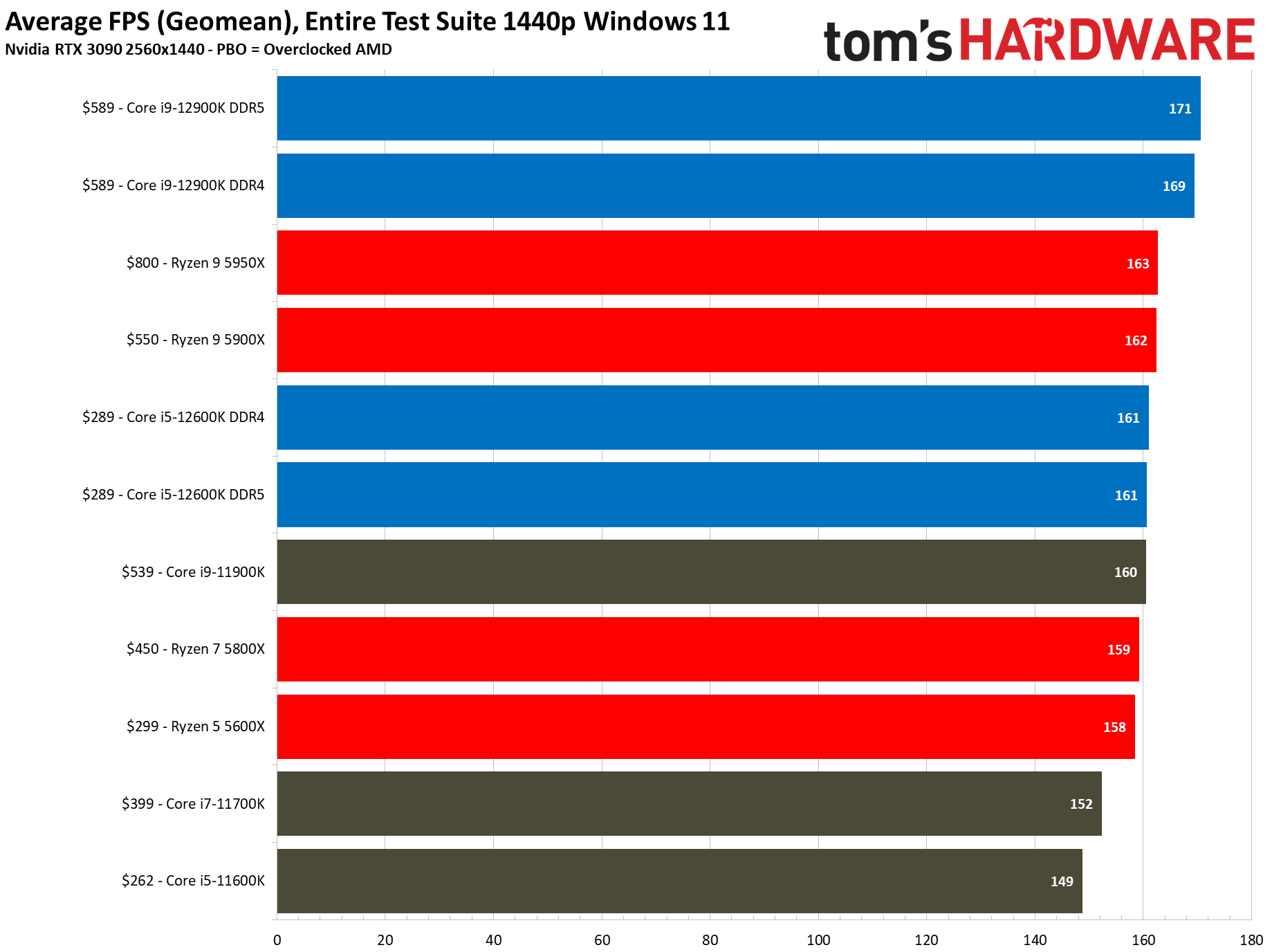
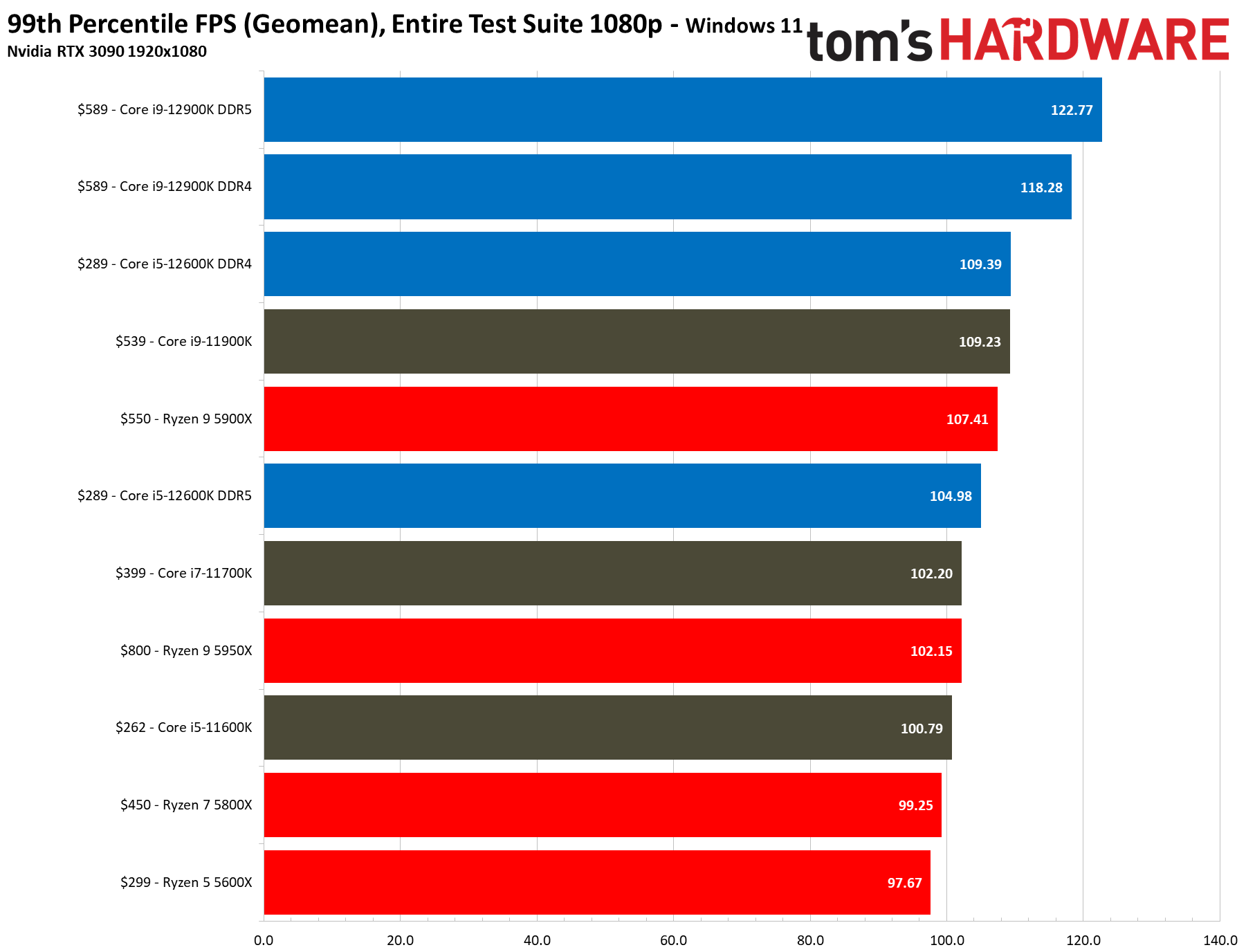
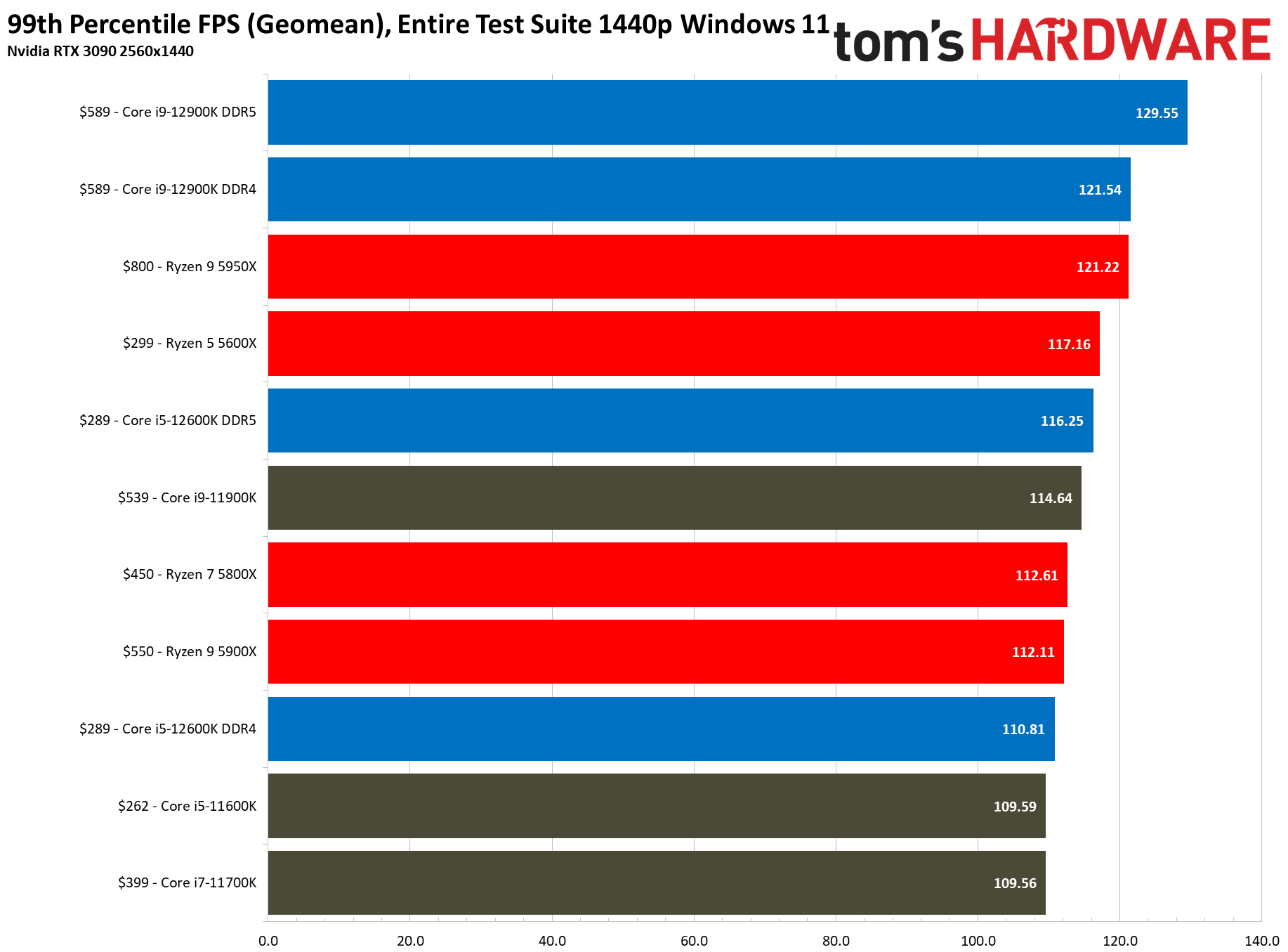
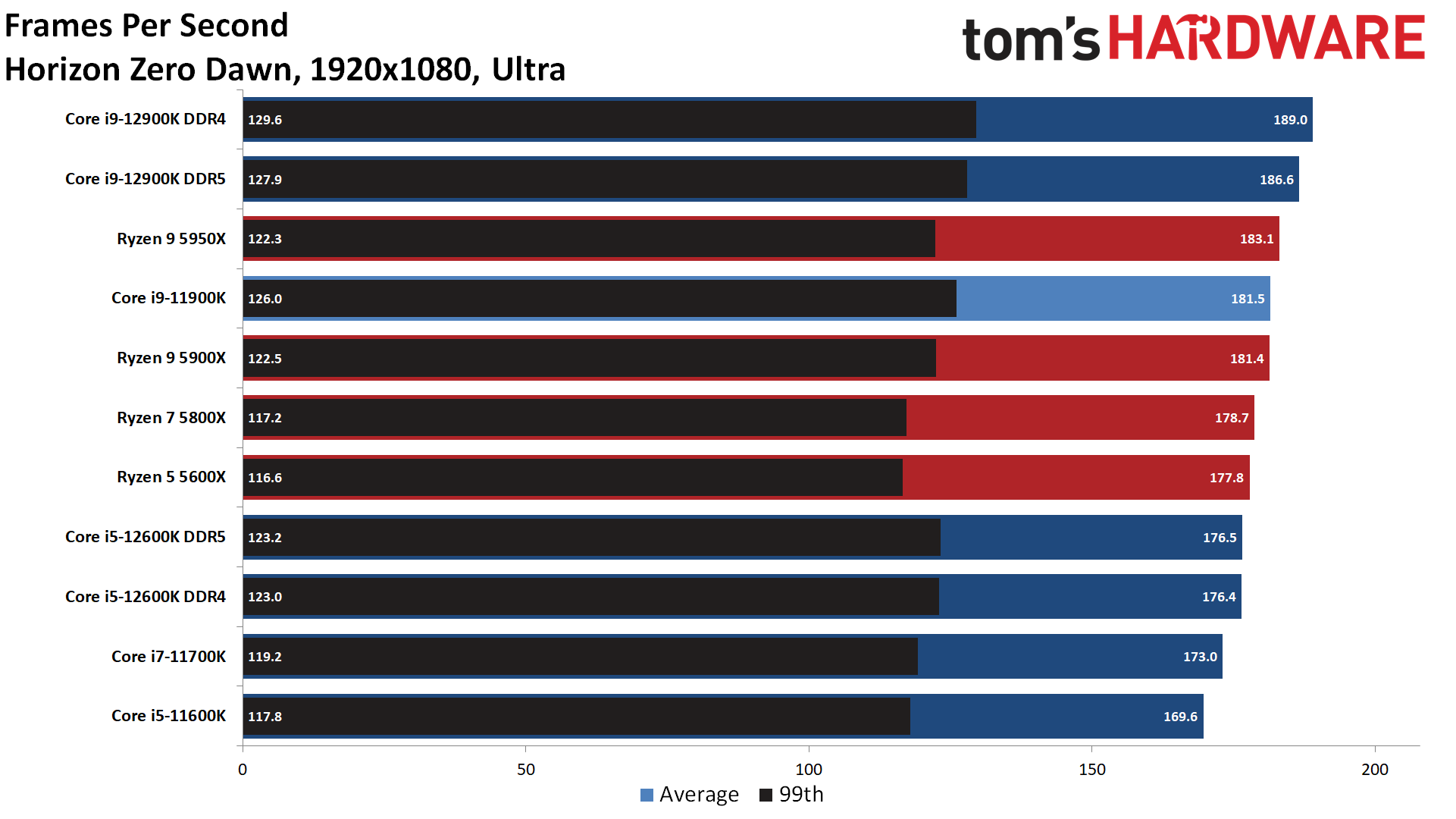
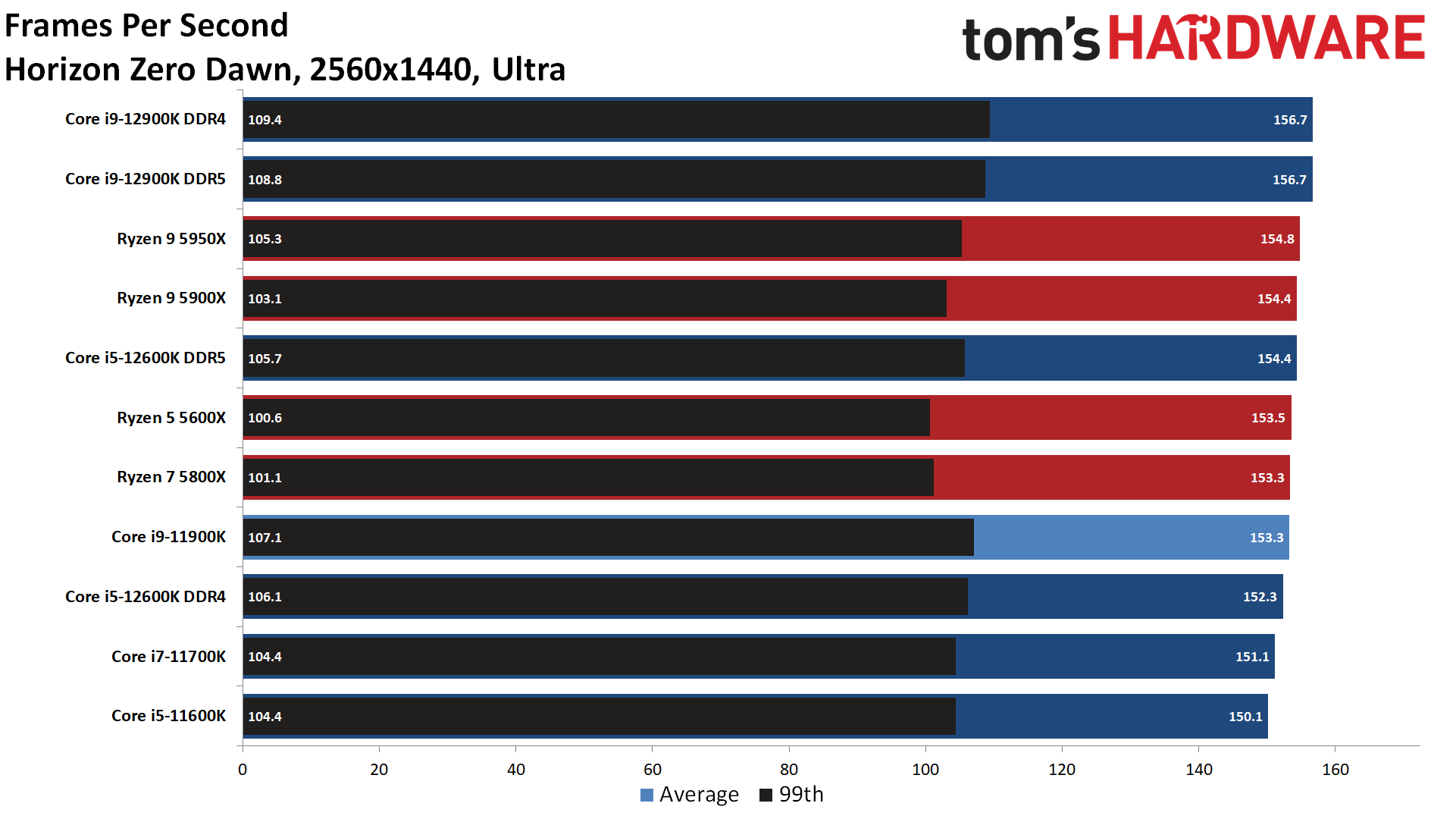

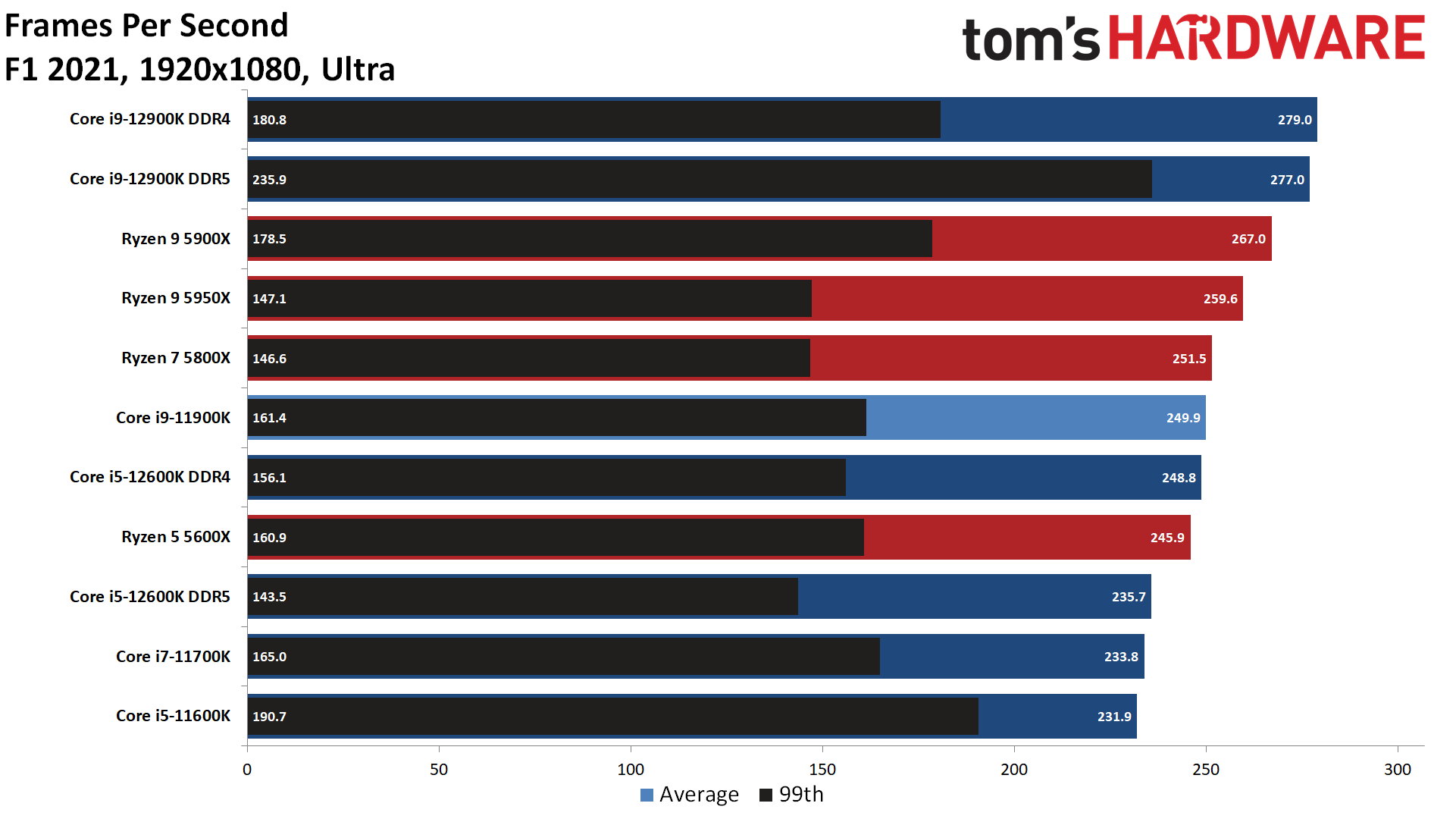
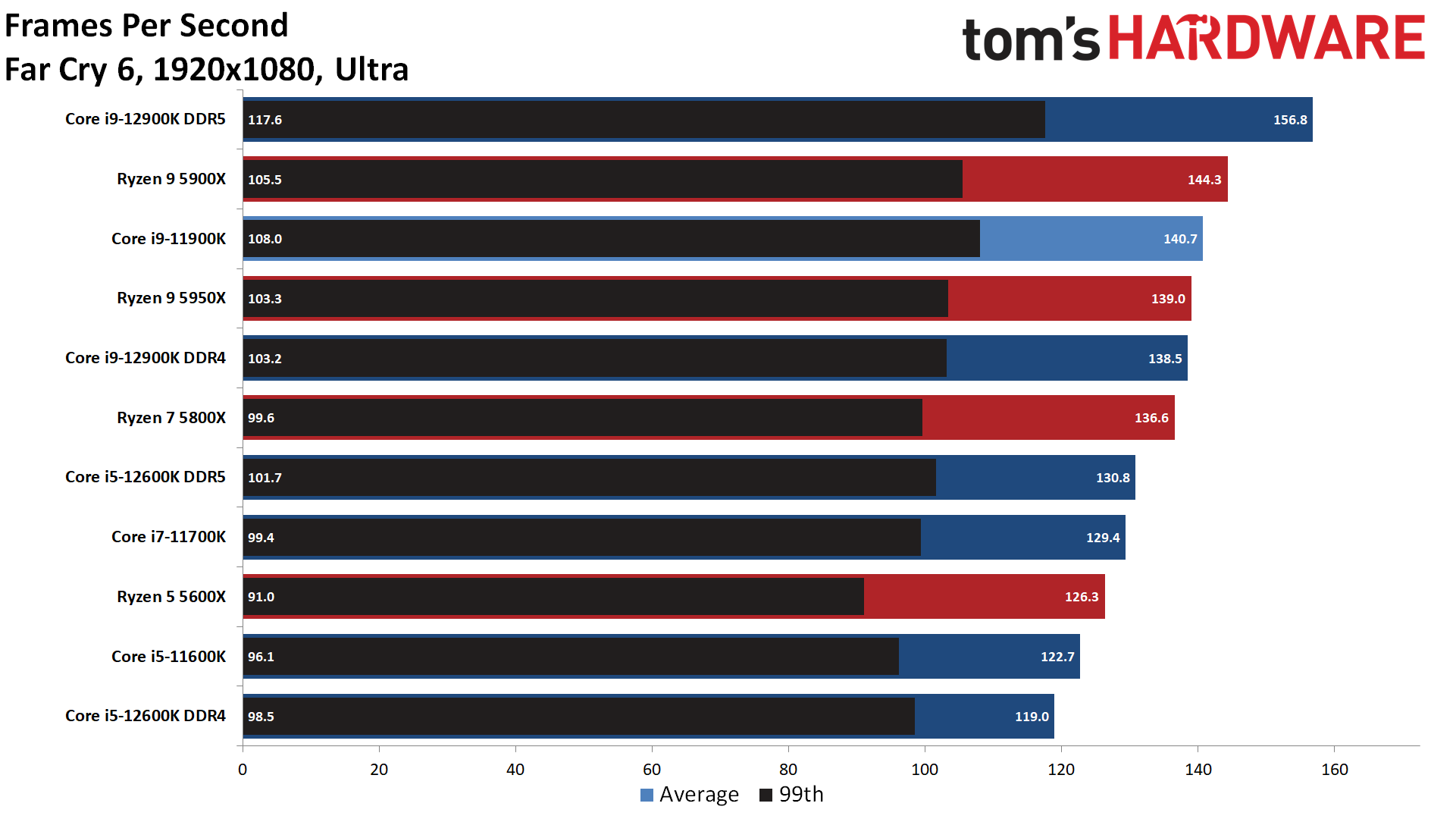

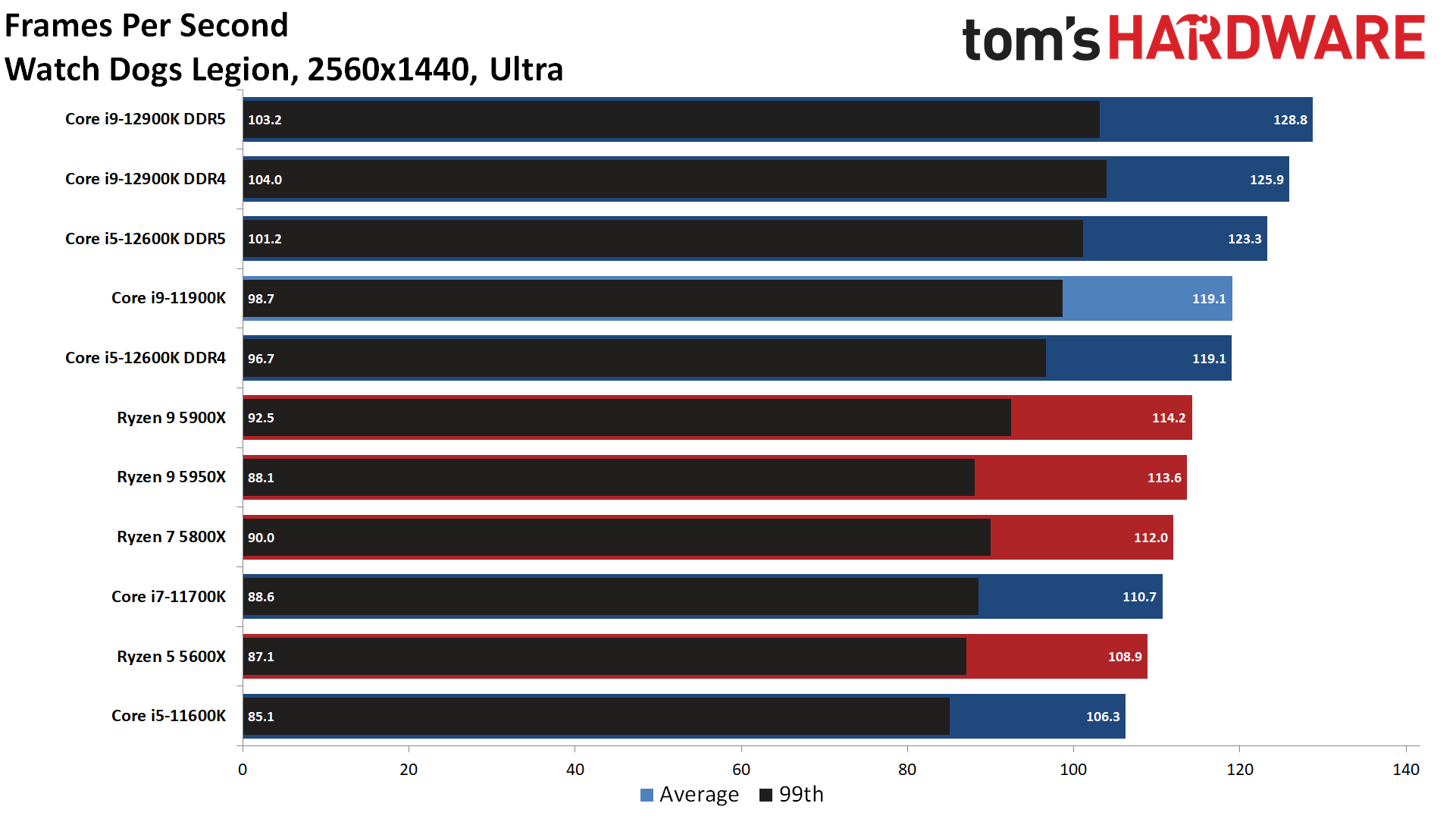
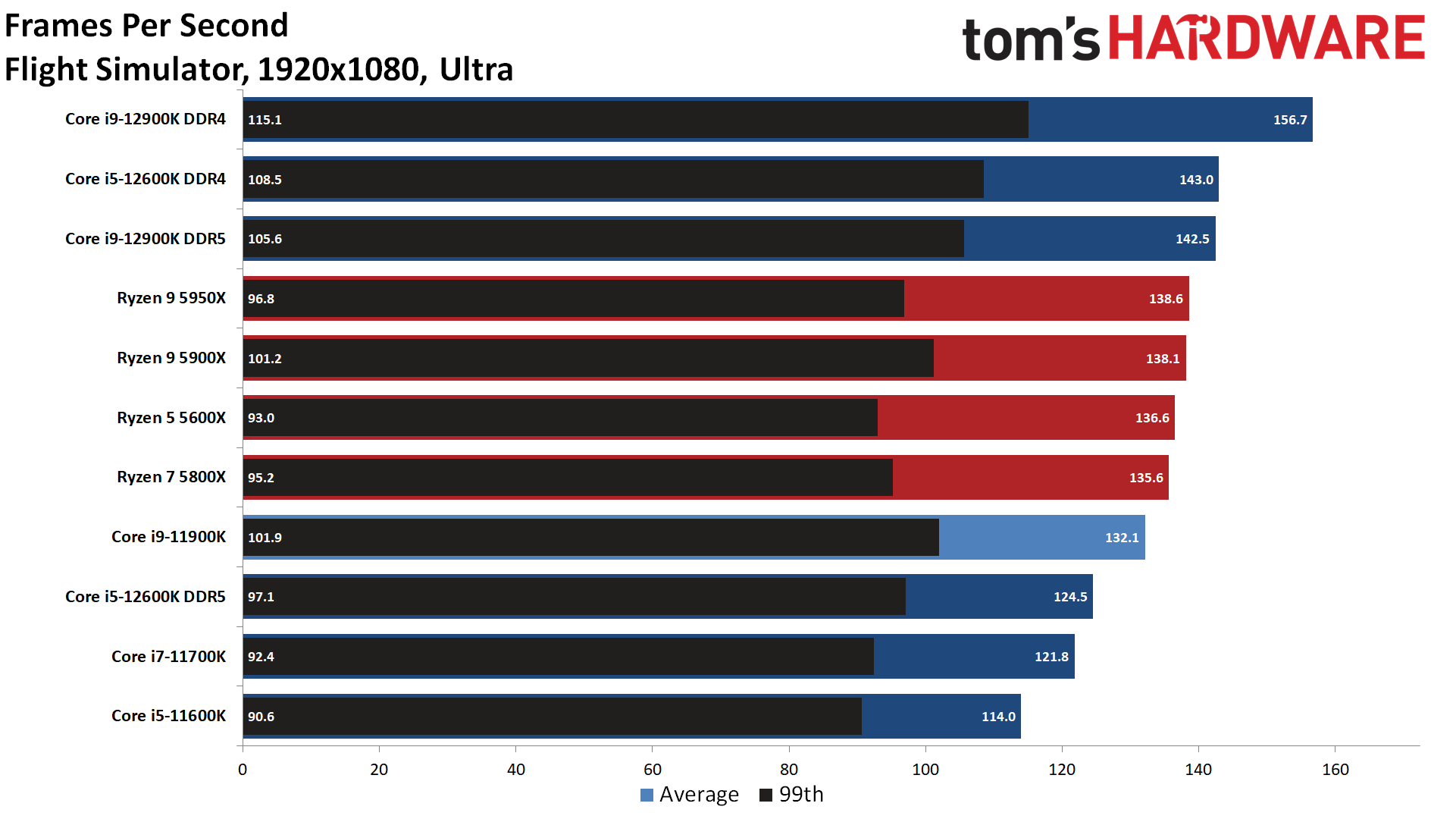

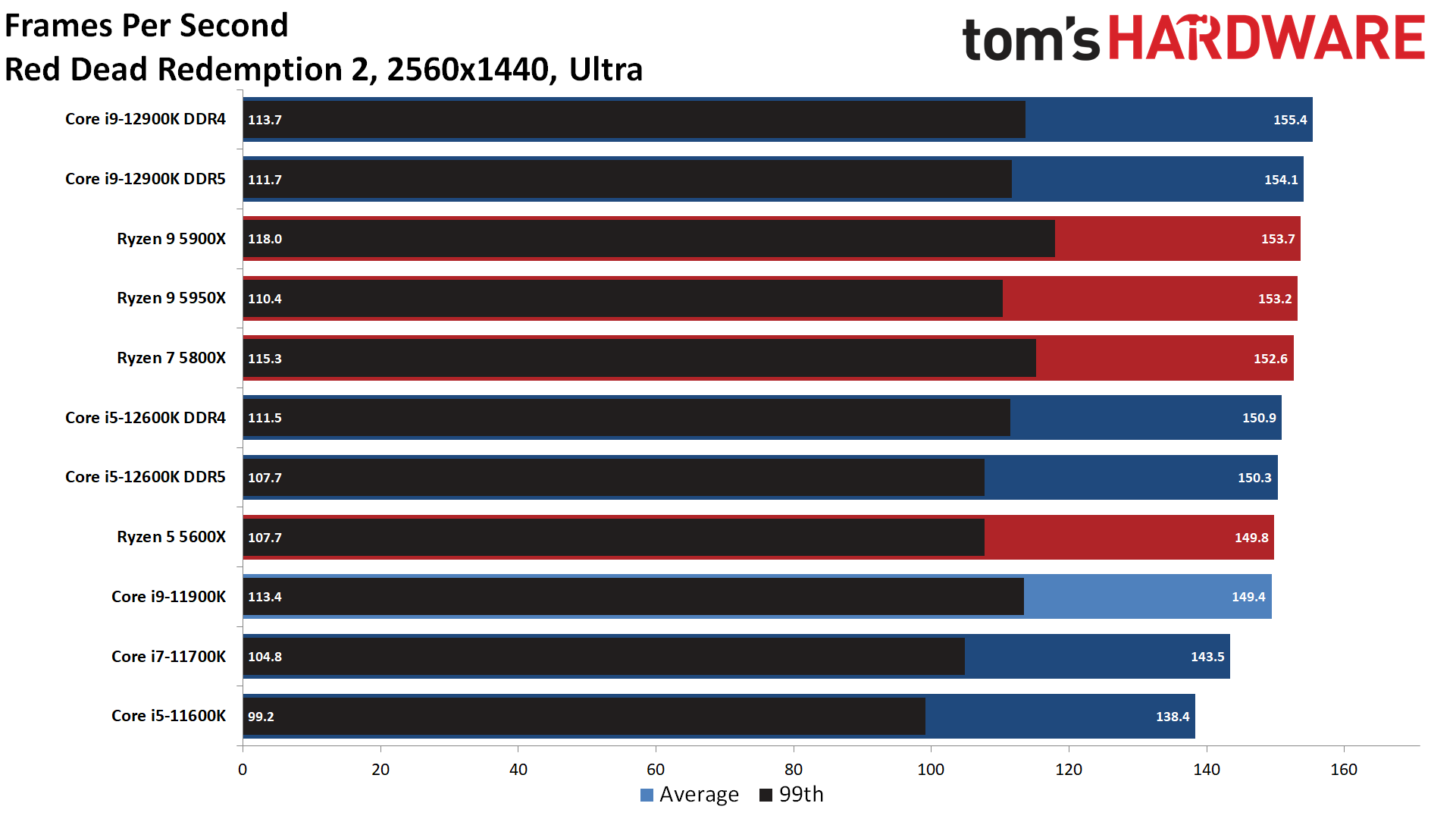
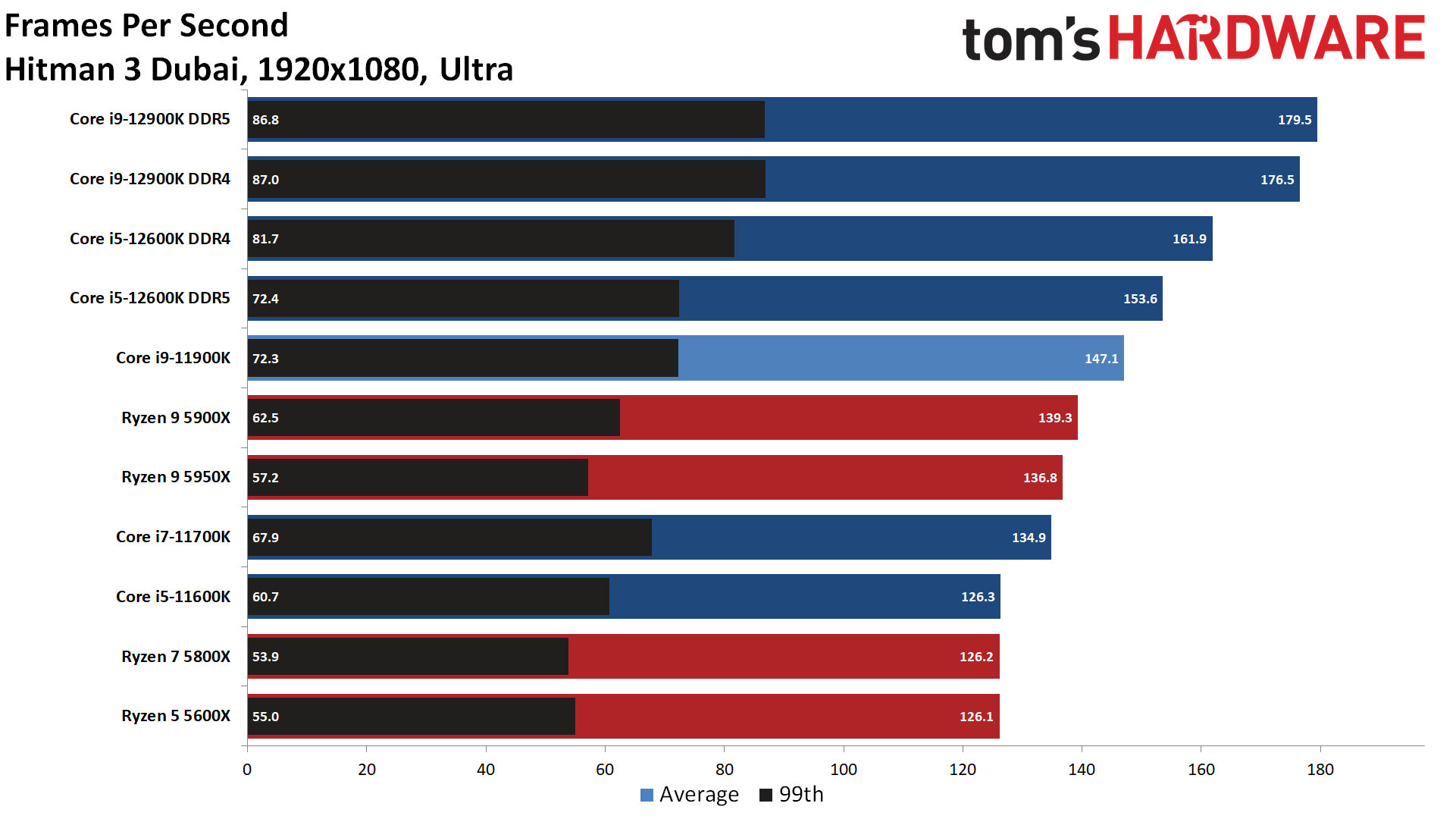

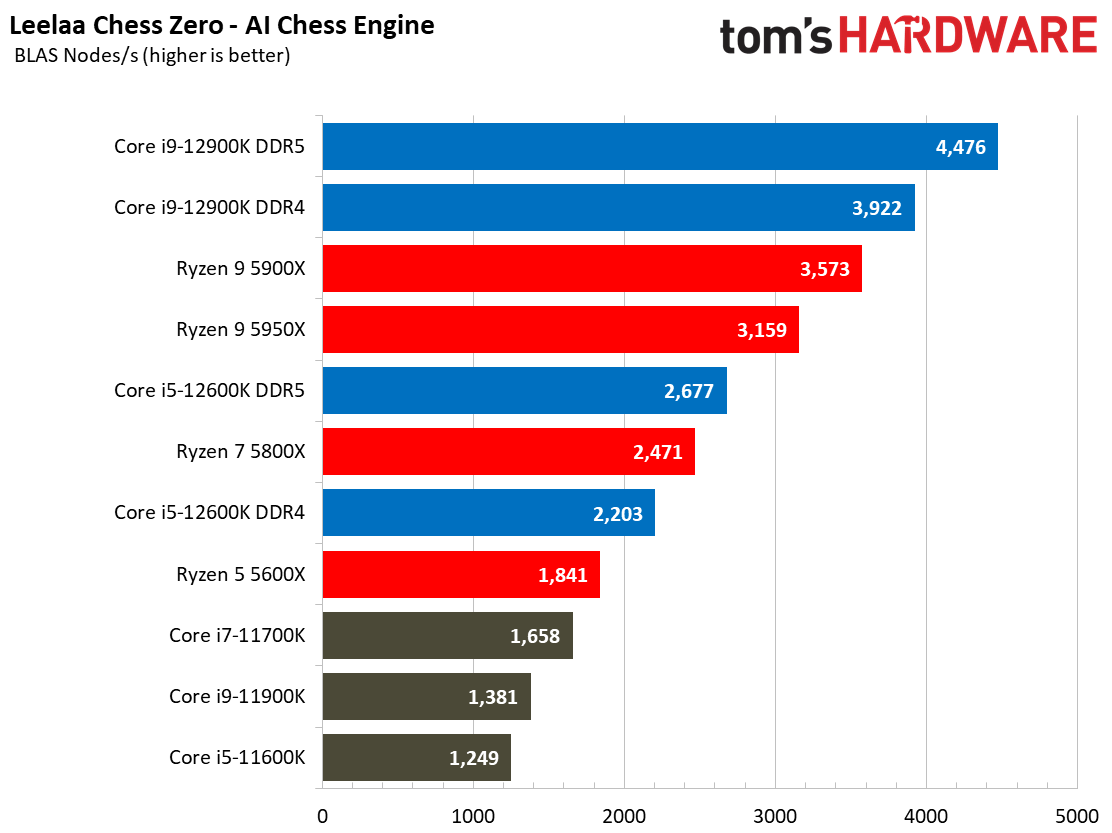


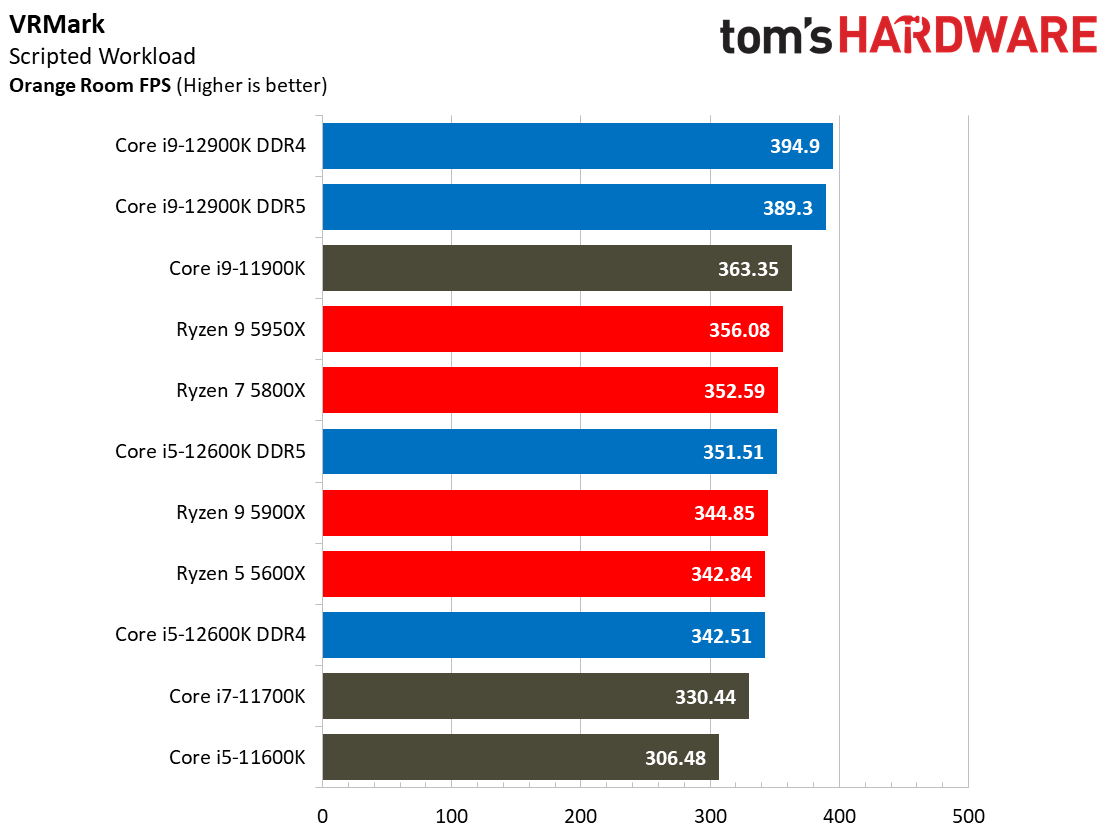


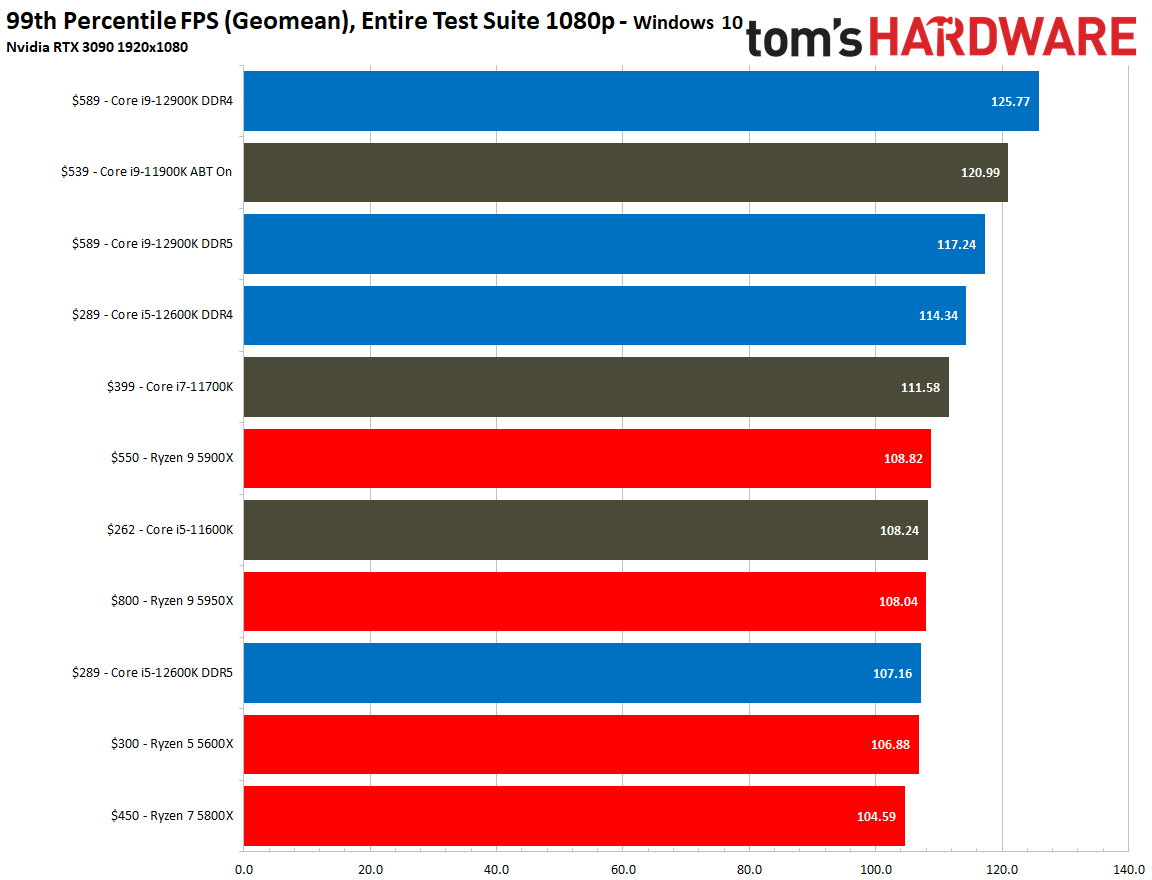
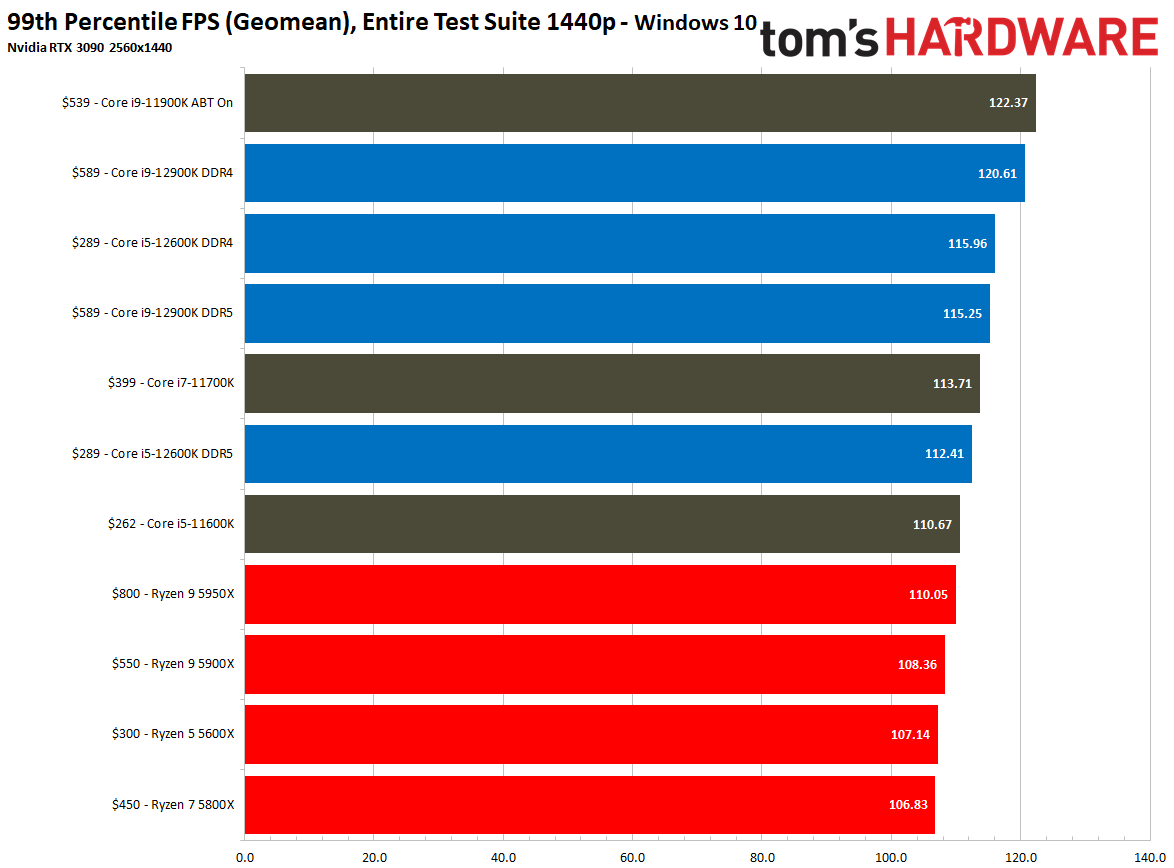
The $549 12-core Ryzen 9 5900X is AMD's fastest gaming chip, but the $589 Core i9-12900K is 8.7% faster in the cumulative 1080p gaming measurement across our entire test suite. And that's with both the DDR4 and DDR5 memory configurations, so you won't have to drop serious cash on a DDR5 kit to get there.
Moving over to 1440p pushes the bottleneck to the GPU, so the difference between the chips shrinks tremendously. At 1440p, the 12900K is just 3.6% faster than the Ryzen 9 5950X, meaning price could be a determining factor if you game at higher resolutions. Gamers with lower-resolution panels with high refresh rates will benefit more from the 12900K's faster frame rates.
Flipping through the 99th percentile charts shows larger deltas between the chips, but we have to view those with caution. Windows 11 is still a bit raw and seems to suffer from more framerate variability than Windows 10. This could stem from yet-to-be-updated game code, the relatively new GPU drivers for Windows 11, or some other combination of factors that could improve in the future.
Intel's Alder Lake takes a convincing lead in Windows 11, but the big wins in a few of the games can greatly impact these types of cumulative measurements. For instance, Intel takes a big lead in Hitman 3, but that game is specifically tuned to leverage the E-cores by offloading low-priority tasks like audio and physics to the small cores. That type of arrangement could become more common, though. For example, Intel says that streaming your gaming session with OBS, which now runs on the smaller E-cores, can result in 84% more fps than its prior-gen chips. We're working on putting that to the test, but it does show that the E-cores could have a big impact on gaming as more games and applications add support.
We also included our overall gaming results with Windows 10 at the end of the album. We generated these values with a different set of games from our previous Windows 10 test suite, but they show that much of what we see in Windows 11 carries over to Windows 10, as well. Except for one thing: DDR4 memory yielded better gaming results than DDR5 in Windows 10. We expect that will change as DDR5 matures.
In Windows 10, the 12900K with DDR4 is 7% faster at 1080p than with DDR5, which naturally impacts its position relative to the Ryzen 5950X and 5900X. With DDR5, the 12900K is 2.4% faster than the Ryzen 9 5900X, but that expands to a 9.5% advantage with DDR4 memory.
The AMD vs Intel gaming competition is closer now, with some games favoring one architecture over the other. As such, it's best to make an informed decision based on the types of games that you play frequently. Be sure to check out the individual tests in the above album. In either case, Intel holds the lead.
Winner: Intel
The Core i9-12900K not only delivers a massive gen-on-gen gaming boost for Intel, but it also accelerates past AMD's Ryzen 9 5900X and the Ryzen 9 5950X during all of our tests in both Windows 10 and 11. That lead also applies to both the DDR4 and DDR5 configurations — Alder Lake wins on all fronts.
Of note: The Denuvo DRM falsely identified Intel's E-cores as a separate system, and thus 22 Denuvo-enabled game titles currently don't work with Alder Lake chips. Ten of those games are expected to be patched by the middle of November 2021, and Intel has issued guidance on a workaround that fixes the issue for all impacted titles. You can read about the simple fix and find the impacted games here. Denuvo says that all affected games will be patched soon.
Application Performance: Intel Core i9-12900K vs Ryzen 9 5950X and Ryzen 9 5900X
We're focusing on Windows 11 application test results for this article, but be aware that we encountered subpar performance in Windows 10 with some of the programs that worked perfectly in Windows 11. These problems arise due to a lack of software optimizations for hybrid architectures.
There are methods to correct those issues in Windows 10, but it could require some manual adjustment until more patches arrive from software vendors. Aside from the odd performance in the Handbrake x264, y-cruncher, Corona and POV-Ray tests, our comparative Windows 10 performance results largely mirrored what we see in Windows 11. Again, head to our review for more detailed information.
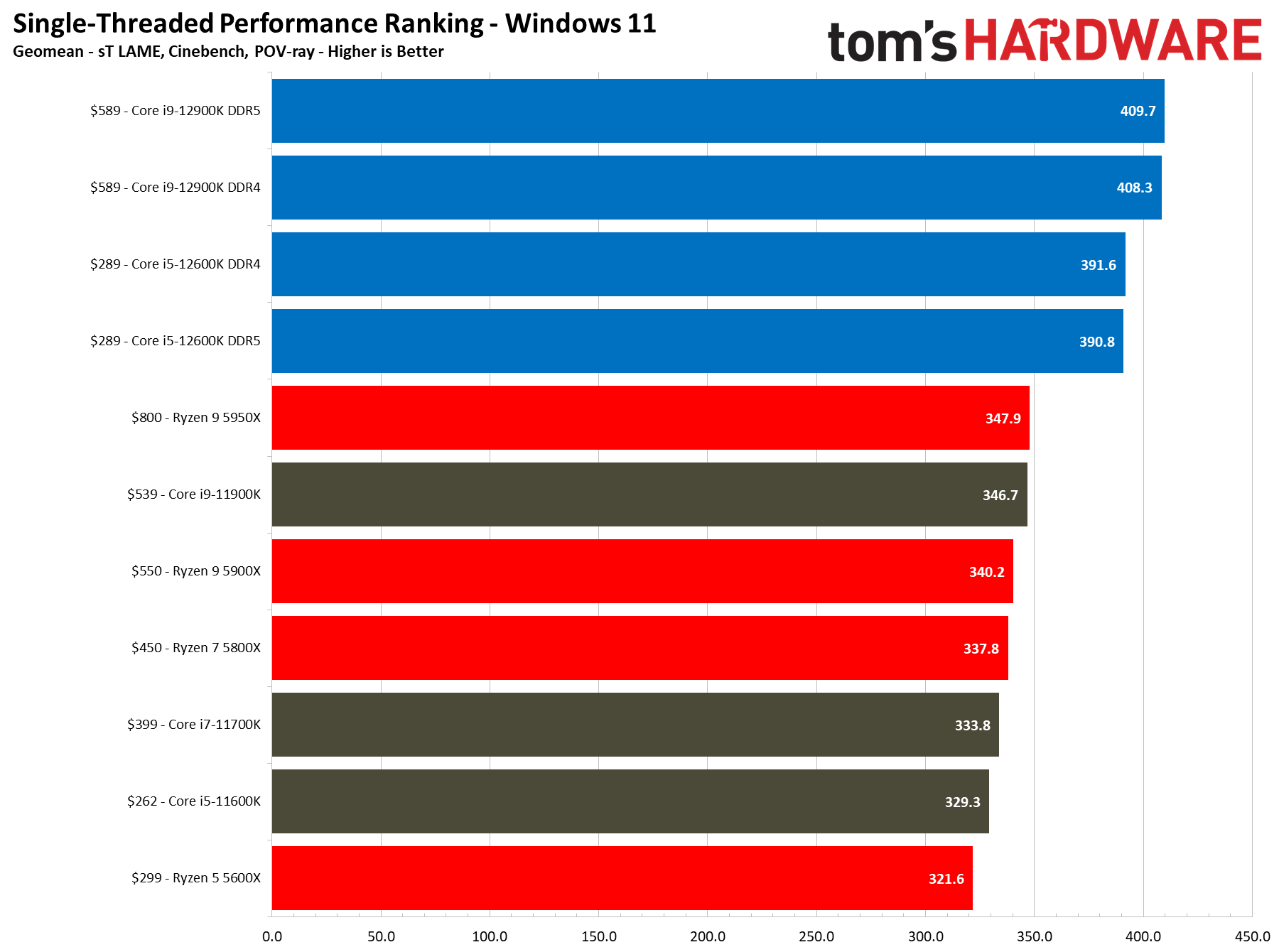

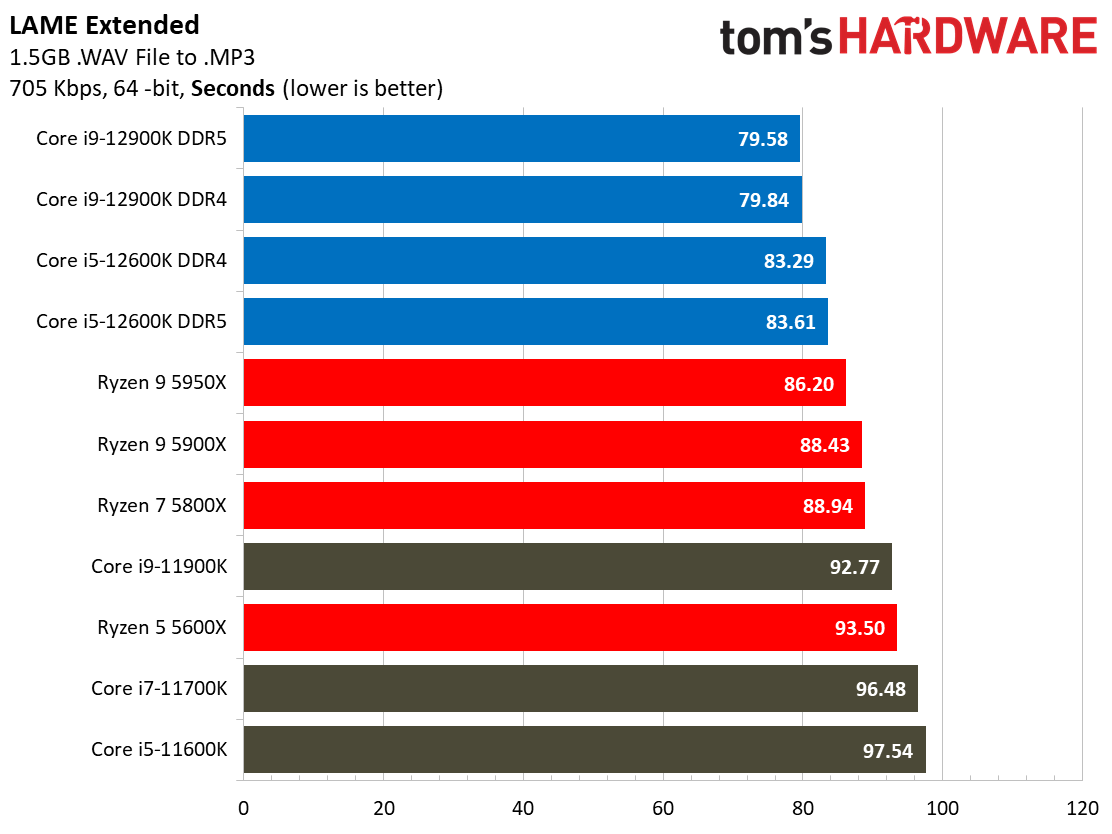
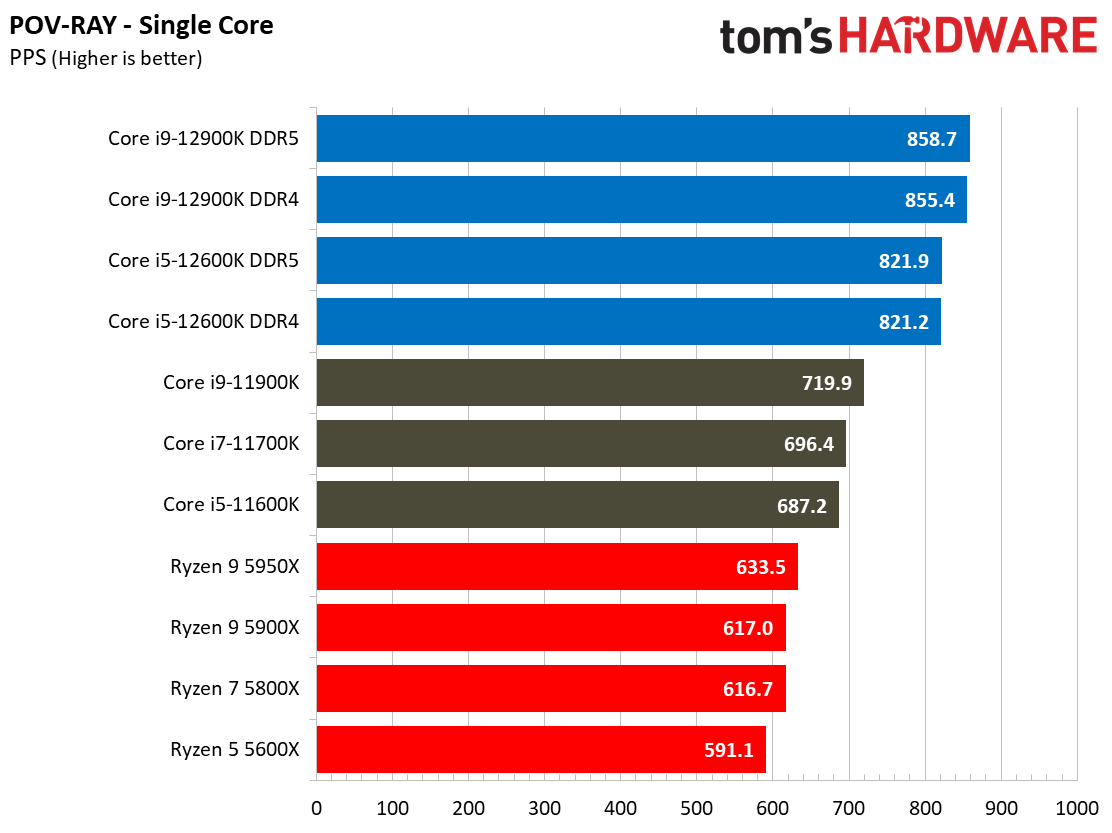
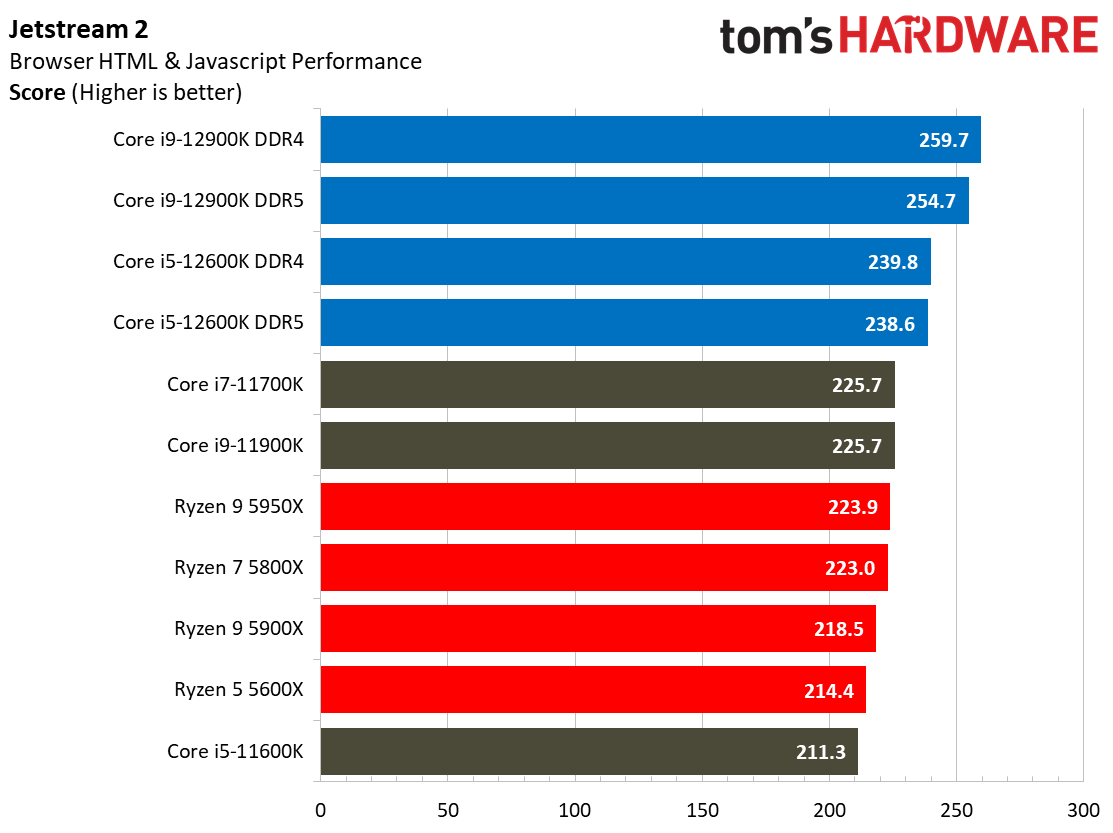

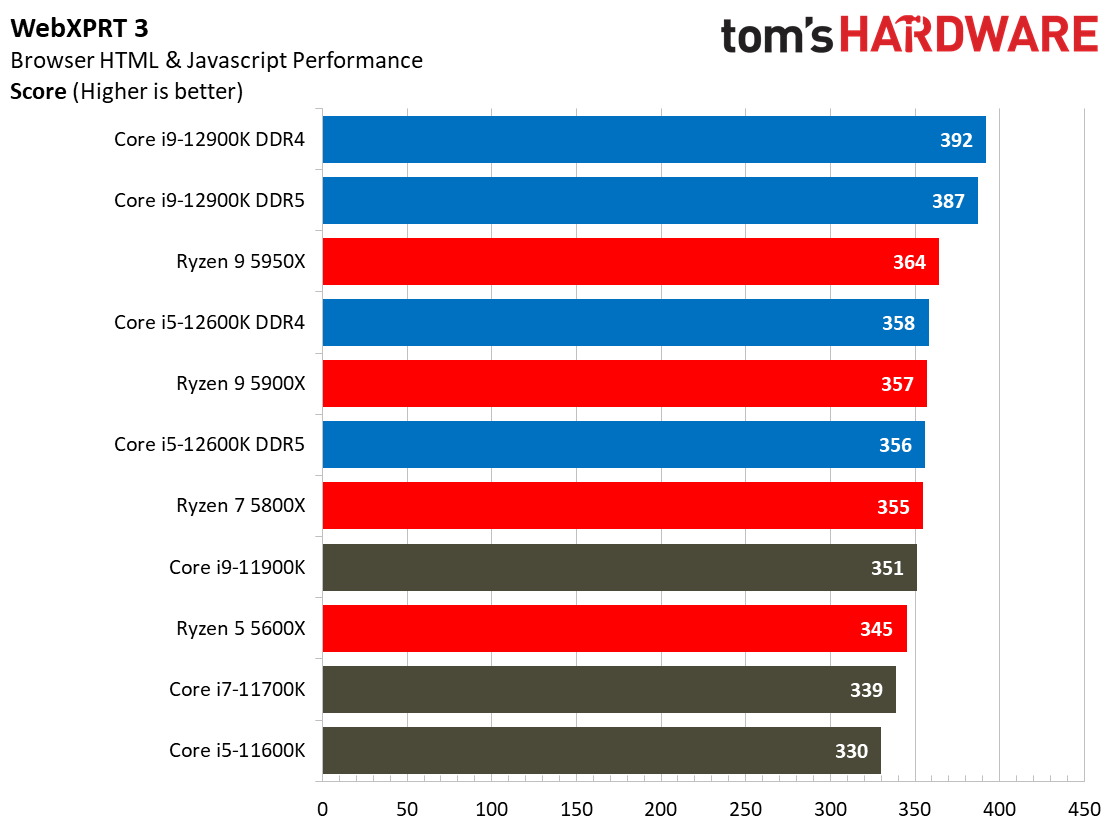
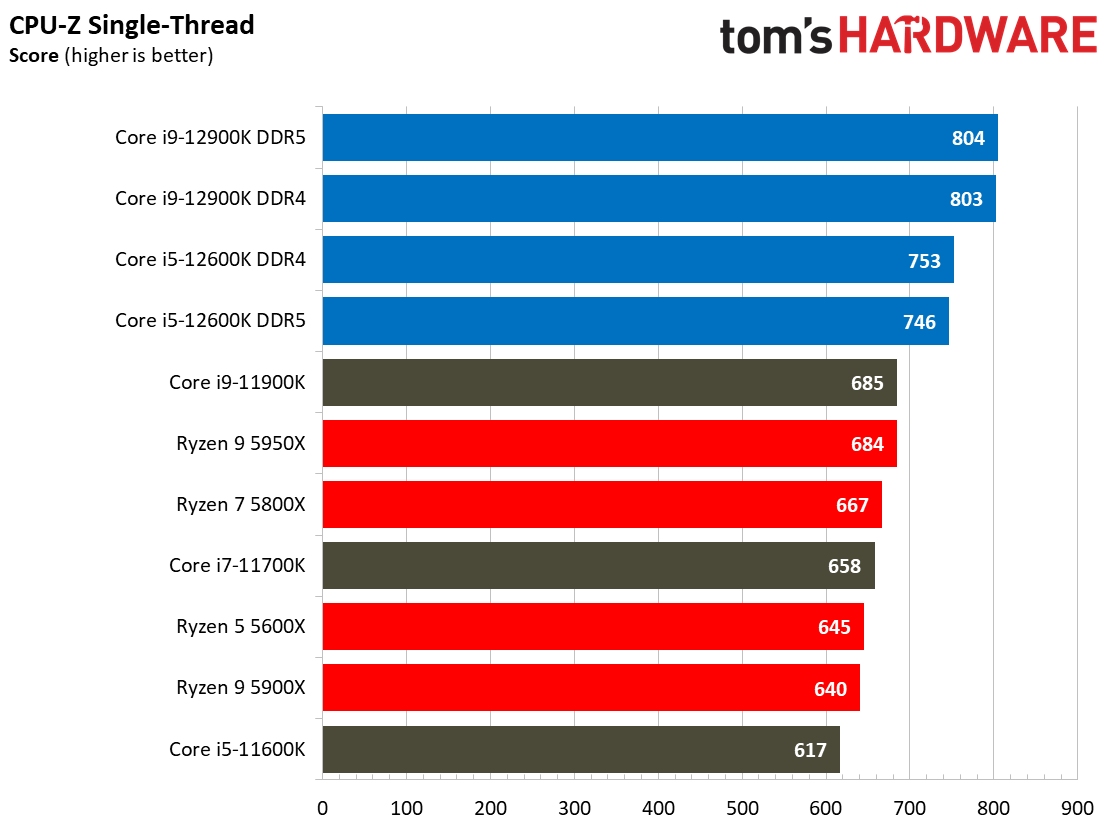


We can boil down productivity application performance into two broad categories: single- and multi-threaded. The first slide above shows the geometric mean of performance in several of our most important tests in each category, but be sure to look at the expanded results below.
The deltas in favor of Alder Lake are very convincing in the overall measure — the Core i9-12900K is 20% faster than the Ryzen 9 5900X and 17% faster than the Ryzen 9 5950X in the single-threaded tasks listed in the chart title. That's impressive.
Naturally, those big performance deltas won't carry over to every type of workload, but flipping through the album of test results reveals that the Core i9-12900K does truly dominate in this type of work. In fact, the Ryzen 9 5900X and 5950X don't win in a single lightly-threaded test.
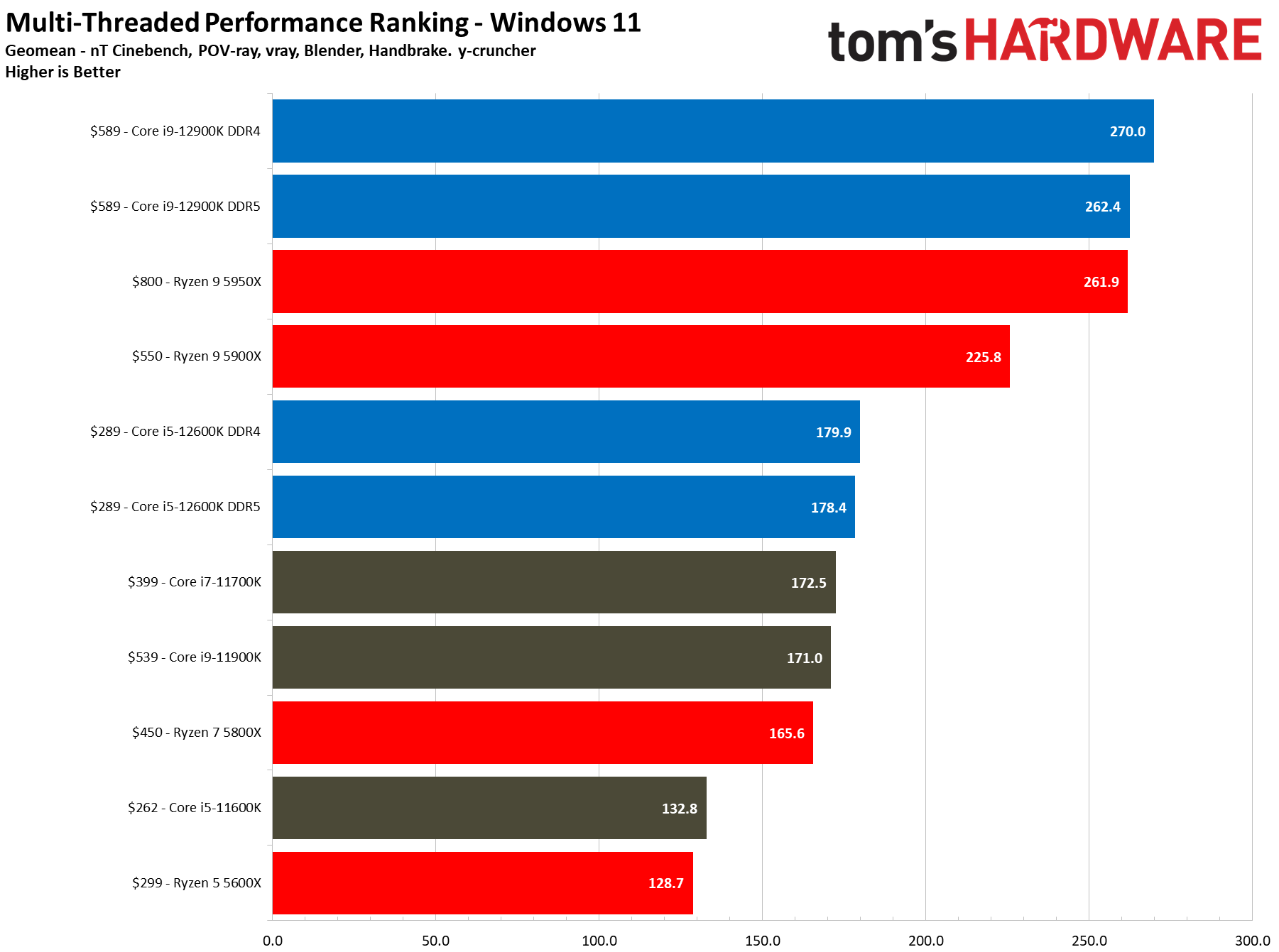
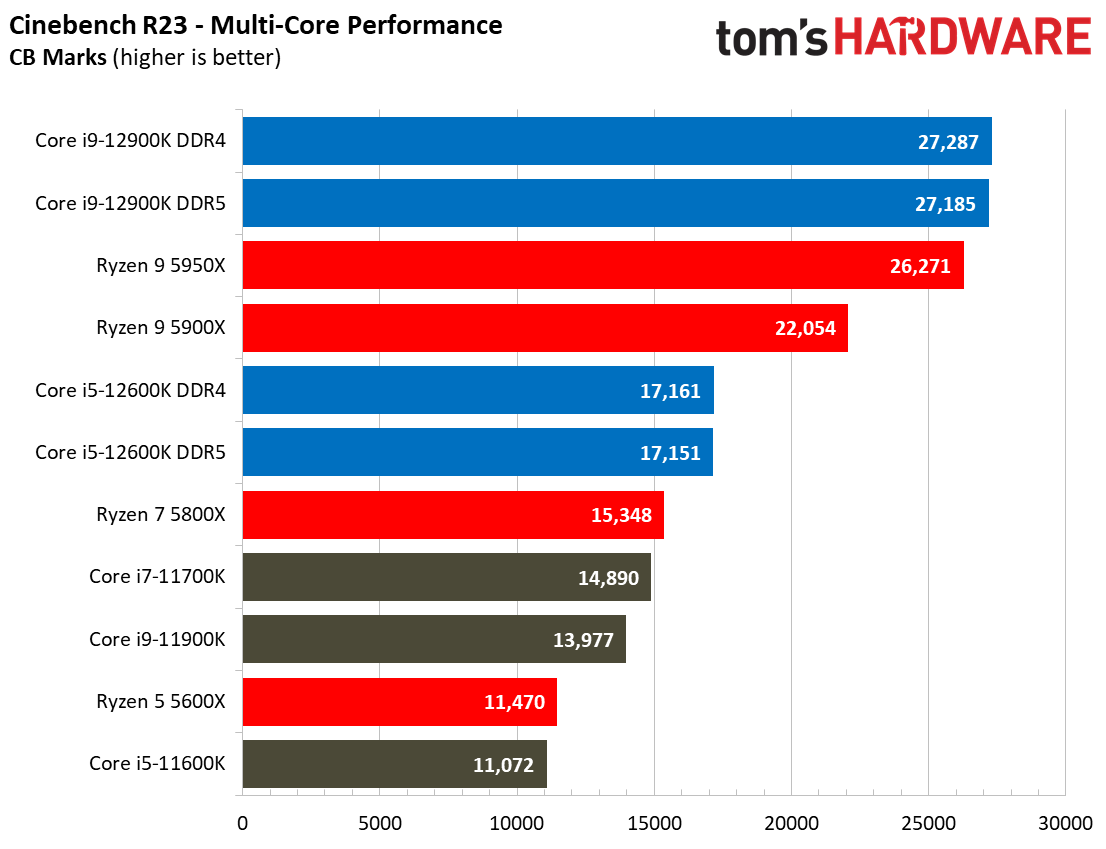
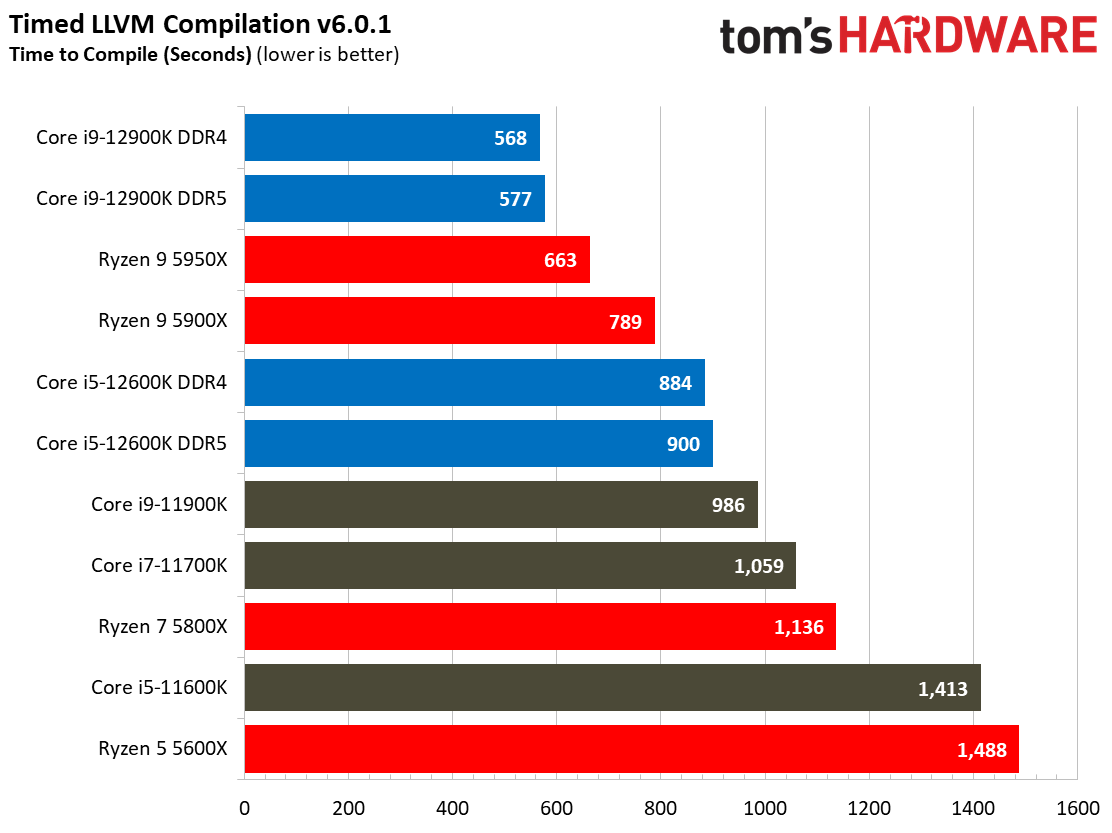

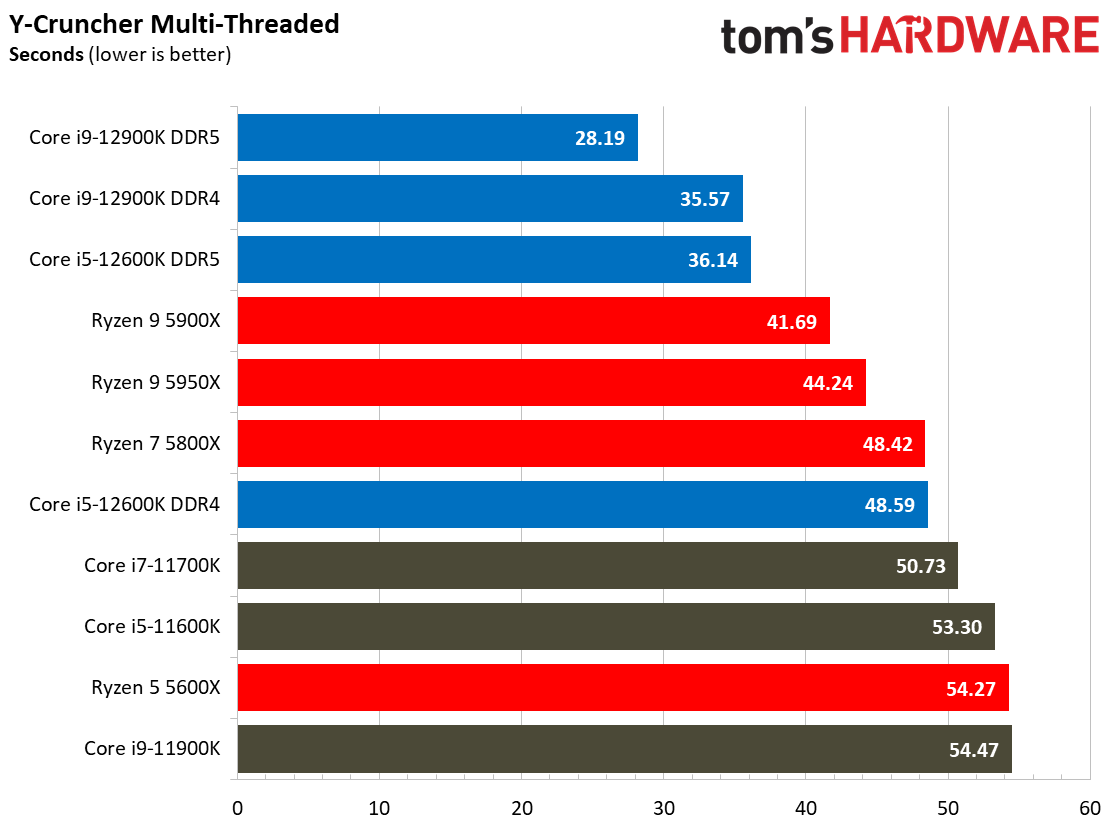
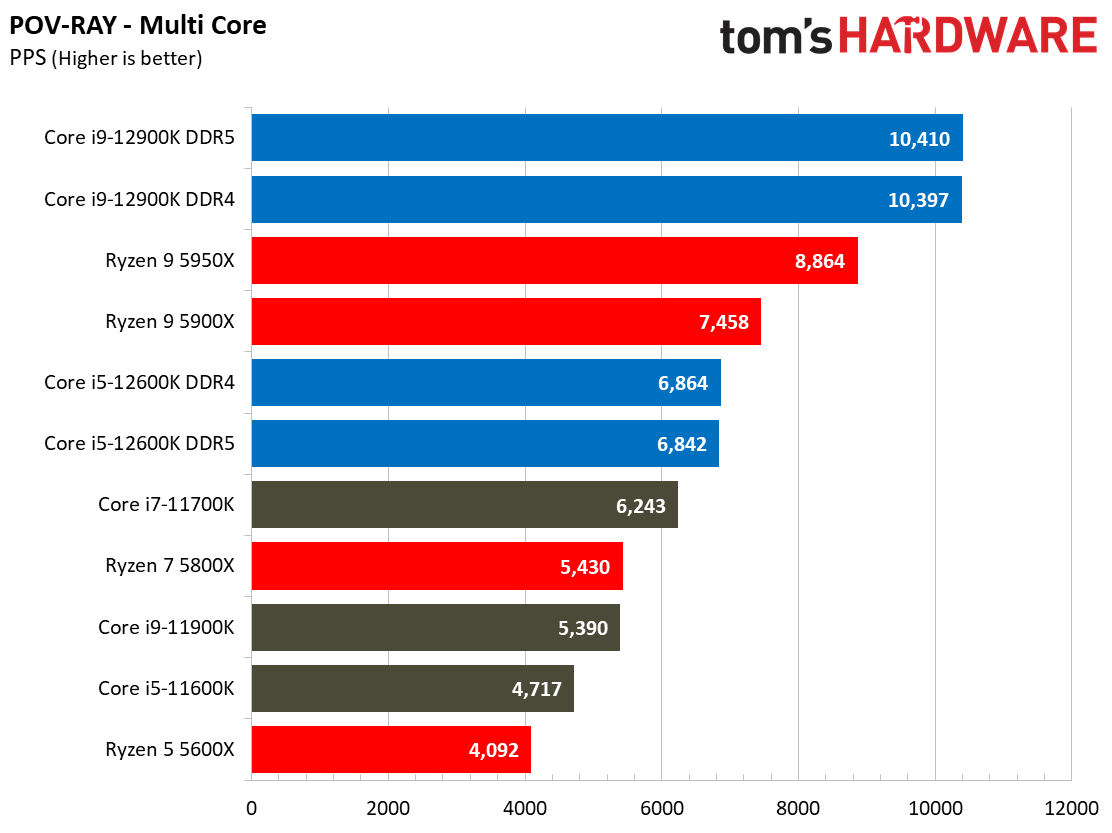

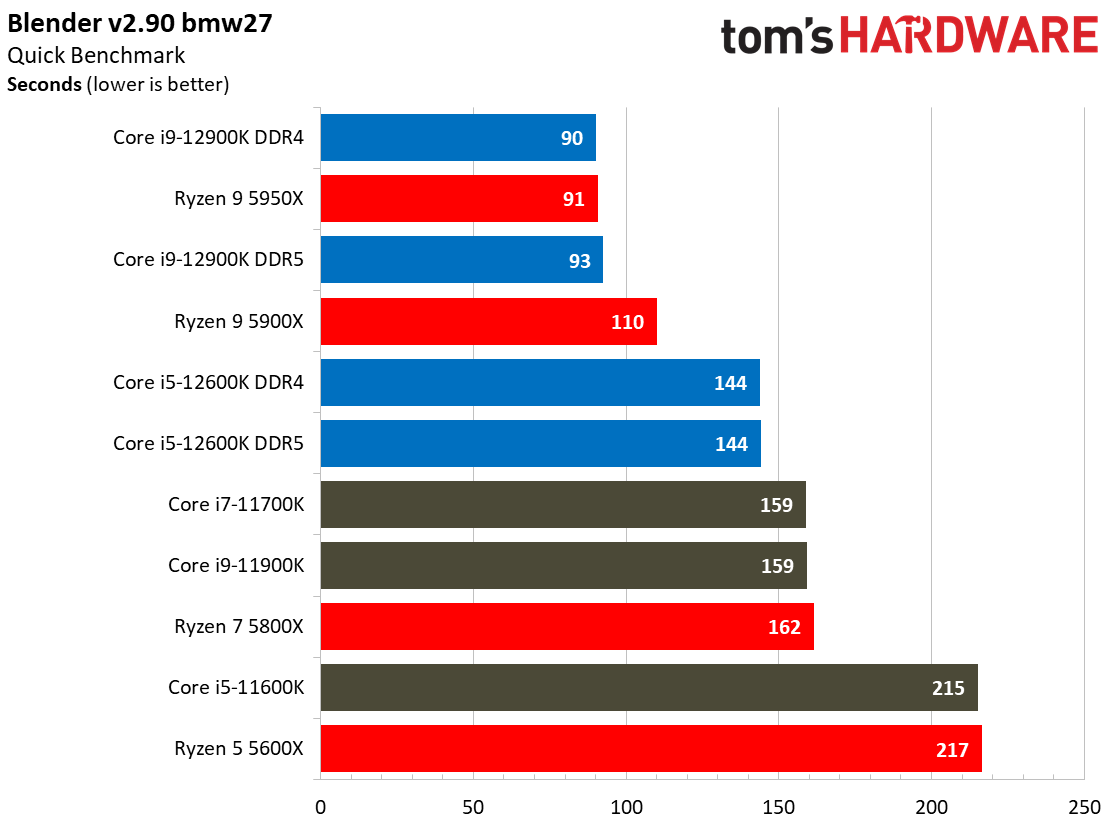




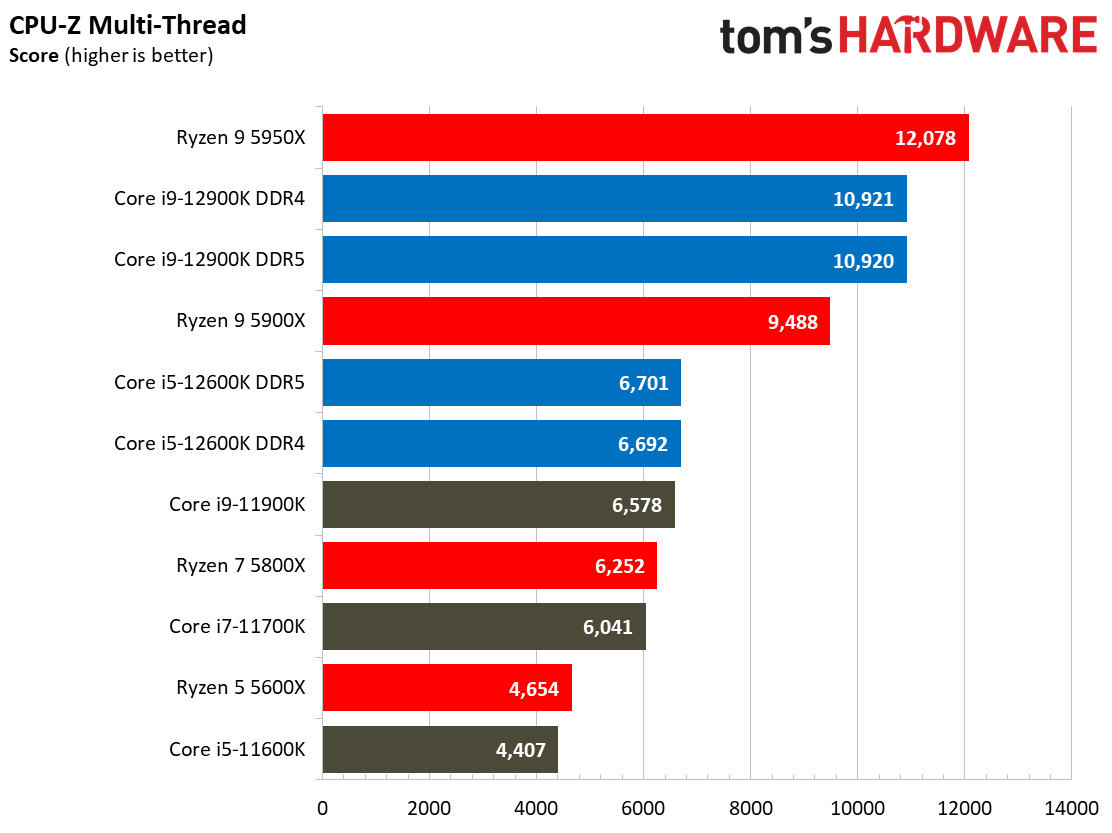
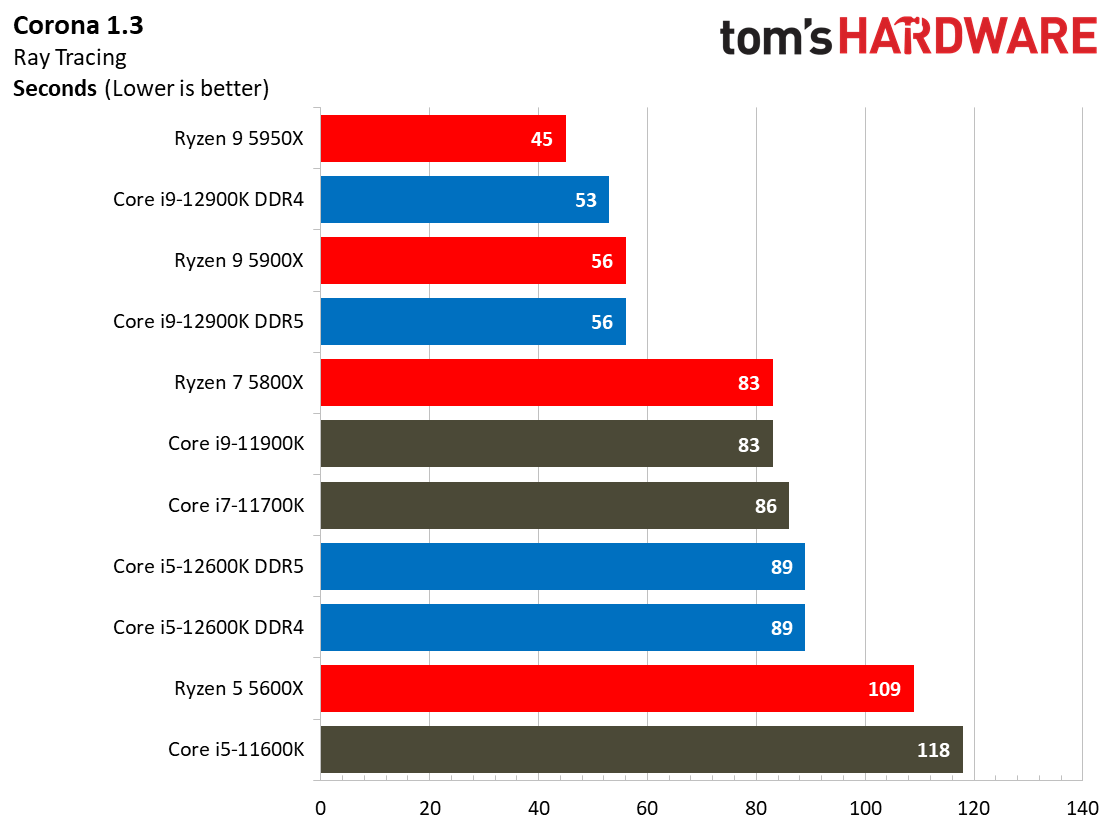

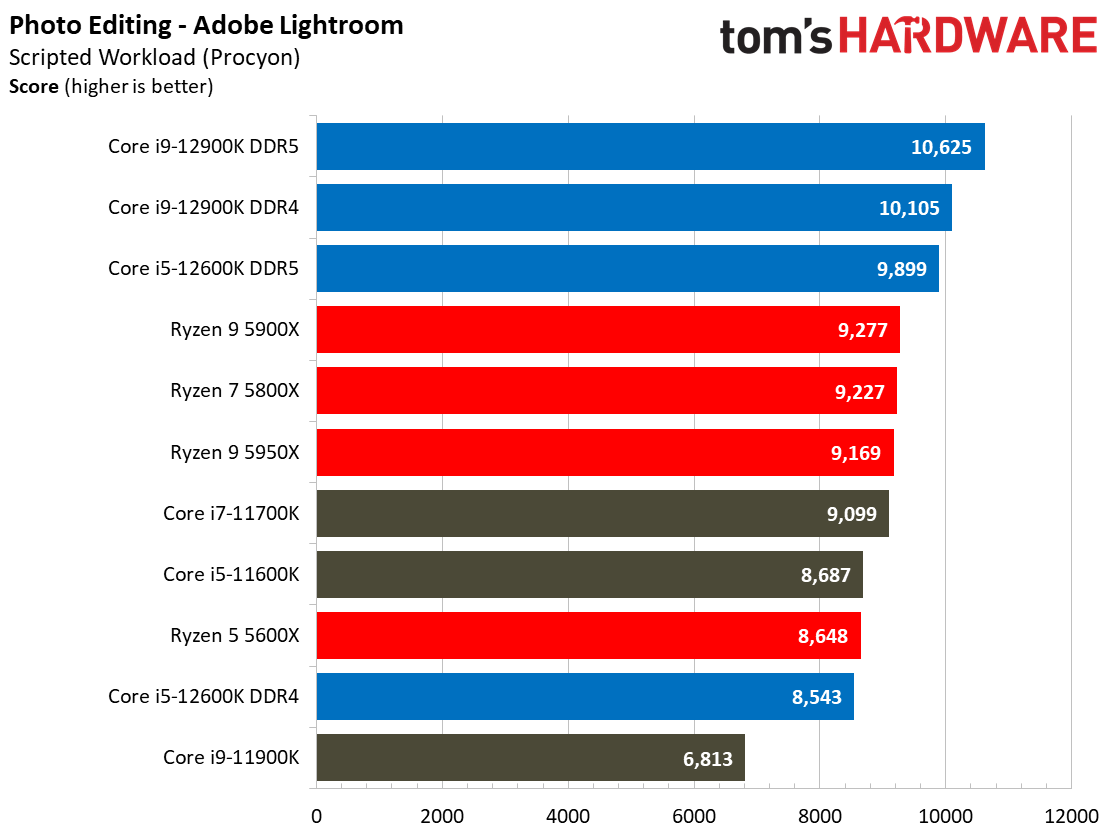

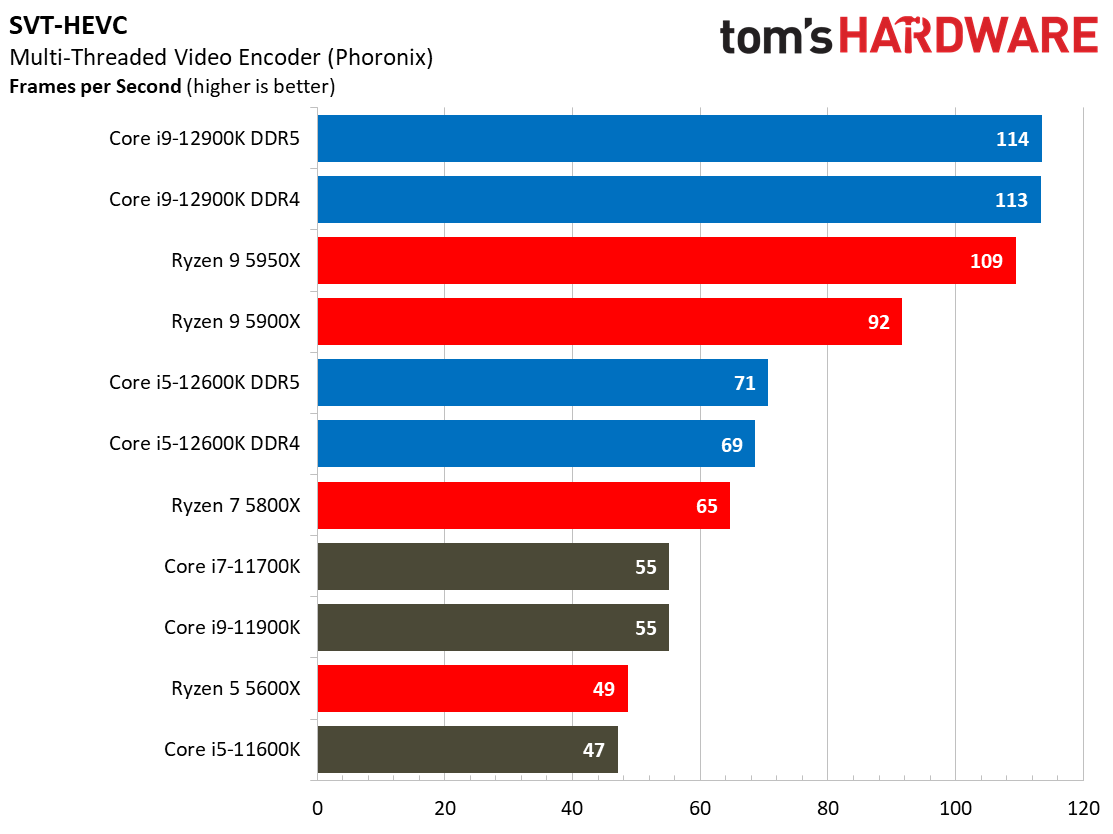
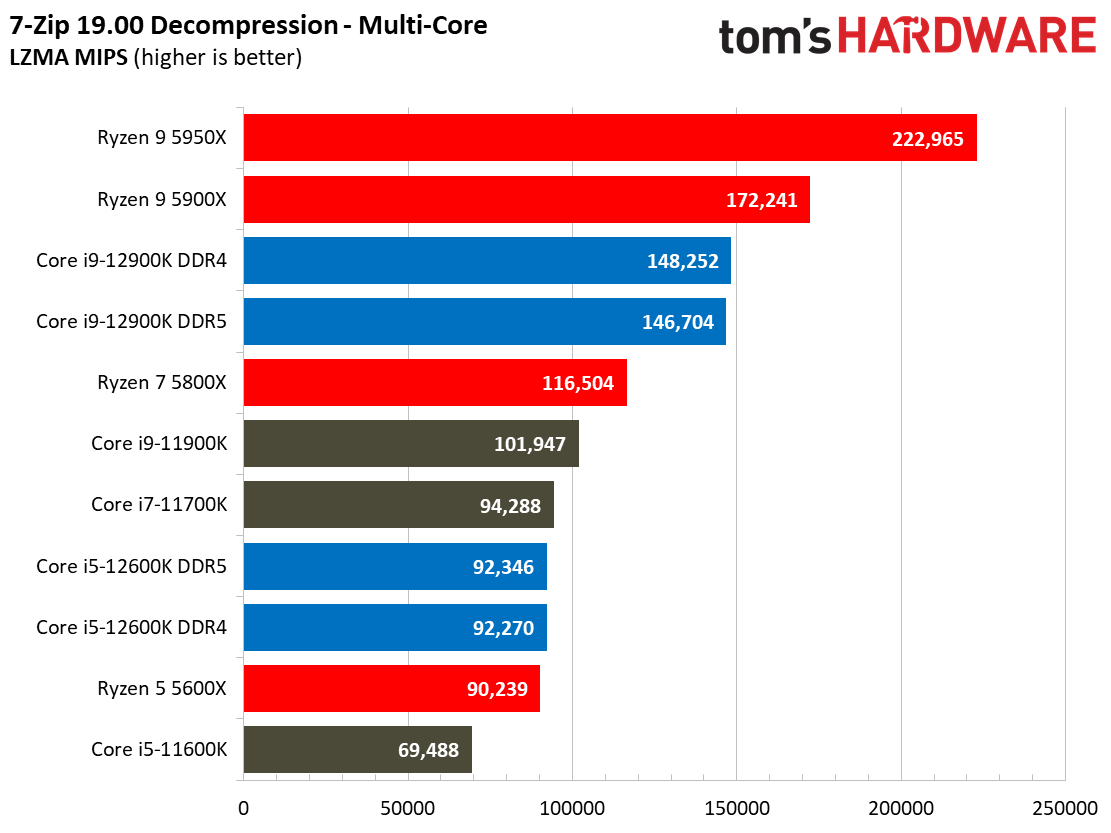
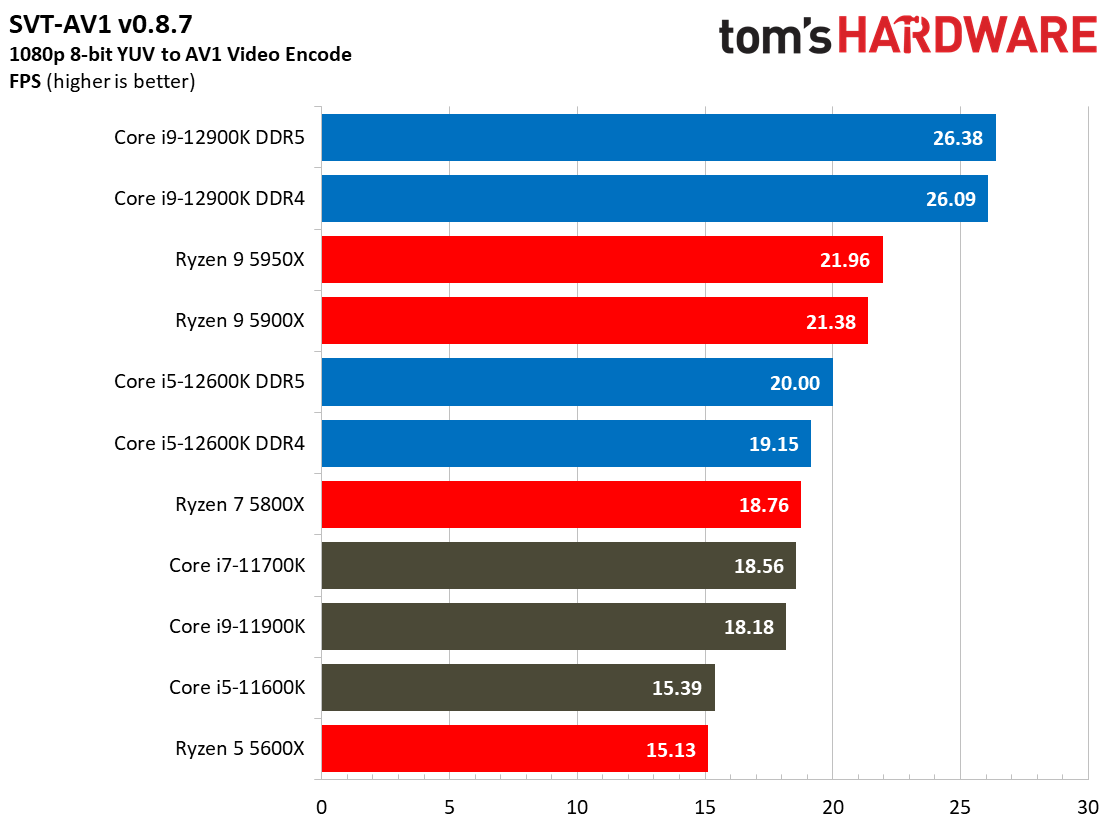
Intel held the single-threaded crown for years before the Ryzen 5000 chips arrived, so it isn't entirely shocking to see it retake the crown. However, the multi-threaded test results are a bit more surprising.
Alder Lake delivers a few stunning wins in the threaded workloads that Ryzen has dominated for so long, highlighting the advantages of the x86 hybrid architecture. It's almost surreal to see the 24-thread Core i9-12900K with DDR5 memory tie the 32-thread Ryzen 9 5950X in the overall multi-threaded ranking, but even more surprising to see it take a 3% lead with DDR4. That's pretty impressive in light of the 5950X's $800 price tag.
Flipping through the slides finds the 16-core, 24-thread 12900K battling toe-to-toe with the Ryzen 9 5950X in what used to be its uncontested turf. The Core i9-12900K is 3.9% faster than the Ryzen 9 5950X in the threaded Cinebench test and 17% faster in POV-Ray, showing that the hybrid architecture exposes exceptionally strong performance despite the lesser thread count. On the other hand, the 5950X takes the lead in a few of the other threaded applications, but by surprisingly slim deltas given its much higher price tag. Remember, the 12900K's pricing is closer to the 5900X.
Meanwhile, the Core i9-12900K simply outguns the Ryzen 9 5900X in these workloads. The 12900K also beats both Ryzen 9 chips in threaded encoding tasks, like Handbrake x264 and x265, SVT-HEVC, and SVT-AV1. Additionally, from the exceedingly branchy code in the LLVM compilation workload to the massively parallel molecular dynamics simulation code in NAMD, the 12900K impresses in heavily-parallelized high-throughput applications.
Winner: Intel
Performance values in a vacuum are meaningless: The true relevance of a benchmark result has to be taken in the context of pricing.
Intel's Core i9-12900K took a stunning lead in single-threaded workloads, winning across the board. The 12900K also beat the Ryzen 9 5900X in every multi-threaded workload while beating the Ryzen 9 5950X in a surprising number of threaded benchmarks.
The 12900K suffered a few losses in heavily-threaded workloads to the Ryzen 9 5950X, but those losses were slim considering the $210 difference between the chips. The 12900K's superior blend of both single-and multi-threaded performance, not to mention its pricing, easily throws the scales in its favor.
It is noteworthy that the Core i9-12900K can suffer in some multi-threaded workloads in Windows 10 due to difficulties with code that has certain prioritization settings. You can correct those issues either via command-line utilities or third-party software, like Process Lasso, and receive the full expected performance. Some vendors have already addressed these teething pains, and we expect the industry to correct many of those issues over time. However, it is important to know that Windows 10 could require additional handholding to extract the utmost performance from the Alder Lake processors.
Overclocking: Intel Core i9-12900K vs Ryzen 9 5950X and Ryzen 9 5900X
We have long since reached the land of diminishing returns for overclocking the highest-end chips from both AMD and Intel, and that includes the Ryzen 9 5900X, Ryzen 5950X and Core i9-12900K. Because AMD has pulled Intel into a heated dogfight for performance superiority on the high end, so much of the overclocking frequency headroom is rolled into standard stock performance. As a result, you'll find larger overclocking gains with the downstream models.
Both Intel and AMD expose a wealth of tunable parameters, along with sophisticated software overclocking utilities like XTU and Ryzen Master. They both also support per-core frequency and hyper-threading control (enable/disable) to help eke out more overclocking headroom.
With Rocket Lake, Intel added support for real-time memory frequency adjustments, though motherboard support will vary by model and vendor. This feature allows you to shift from, say, DDR4-2933 to DDR4-3200 from within Windows 10 without rebooting.
Now the company has expanded that with Dynamic Memory Boost. This new tech works with both DDR4 and DDR5 and allows the system to dynamically switch between standard memory frequencies and timings and an XMP profile, meaning that it will auto-overclock the memory as needed based on the current usage pattern. And yes, this occurs while the operating system is running and doesn't require a reboot — it's a real-time dynamic adjustment. Intel also continues to support its existing mechanism for live memory timing adjustments from within the operating system, giving users a plethora of on-the-fly memory overclocking options.
Intel has long locked overclocking to its pricey K-series models, while AMD freely allows overclocking with all SKUs on almost any platform. However, we see signs of some improvement here from Intel, as it has now enabled memory overclocking on its B- and H-series chipsets with the 500-series chipsets, and it appears that the same policy will hold true with the 600 series.
AMD's Ryzen 5000 chips come with innovative boost technology that largely consumes most of the available frequency headroom, so as we see with Intel's flagship, there is precious little room for bleeding-edge clock rates. In fact, all-core overclocking with AMD's chips is lackluster; you're often better off using its auto-overclocking Precision Boost Overdrive 2 (PBO2) feature that boosts multi-threaded performance. AMD also has plenty of Curve Optimization features that leverage undervolting to increase boost activity.
In contrast, Intel's Alder Lake chips seem to be constrained by heat output — we obtained a 5.2-GHz overclock on the P-cores and a 4.0 GHz overclock on the E-cores with DDR5 locked in at DDR5-5200. We're sure a better cooler would allow us to push even further, though it would come with an unacceptable increase in power consumption. However, chip quality can vary for both vendors, so these values should serve as a general indicator of possible overclocking headroom.
Winner: Tie
Both platforms have a wealth of tunable parameters for enthusiasts, their respective overclocking advantages, and a suite of both auto-overclocking and software utilities. There's also still room for a sizeable performance boost from overclocking the core, fabric, and memory, meaning this contest will often boil down to personal preference.
Power Consumption, Efficiency, and Cooling: Intel Core i9-12900K vs Ryzen 9 5950X and Ryzen 9 5900X
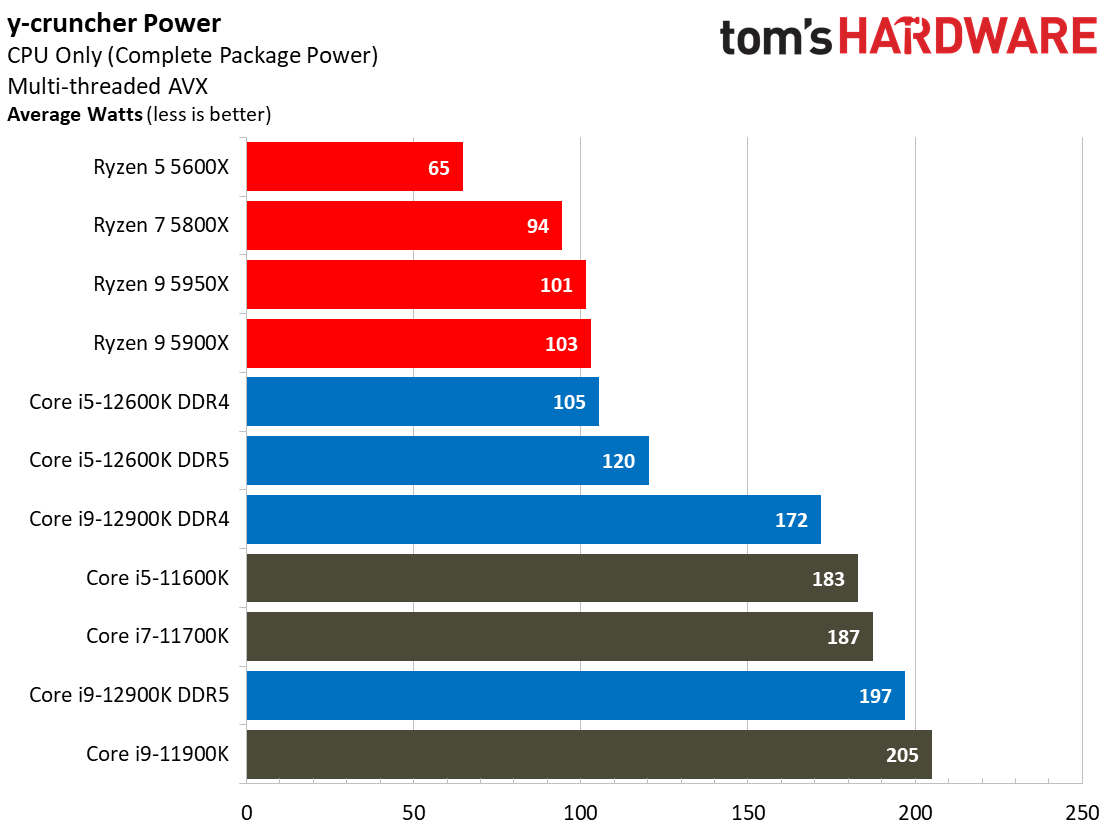
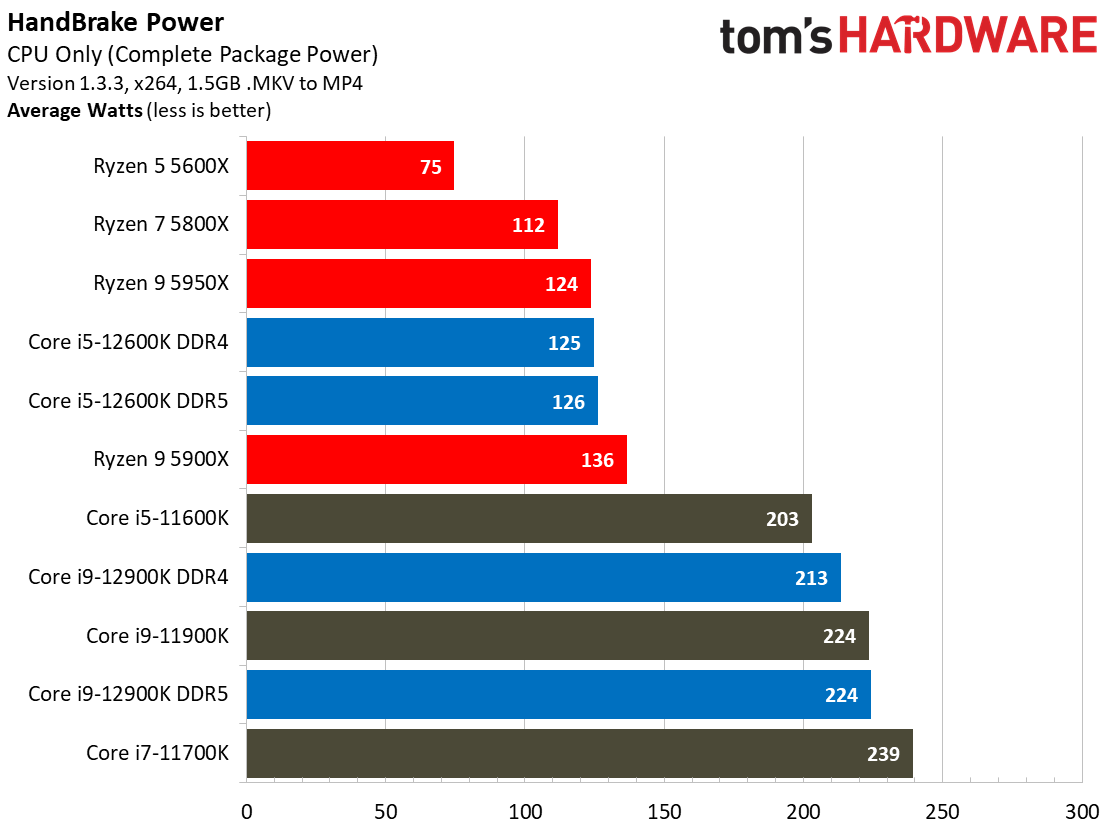



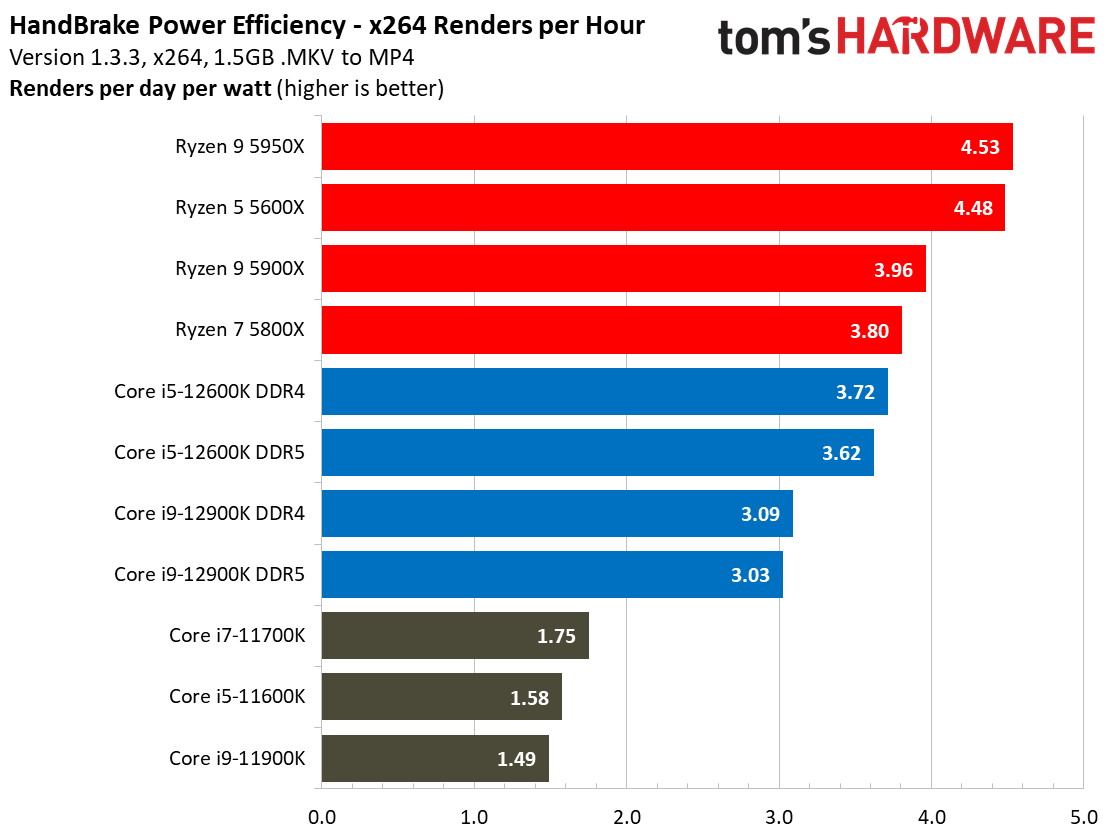
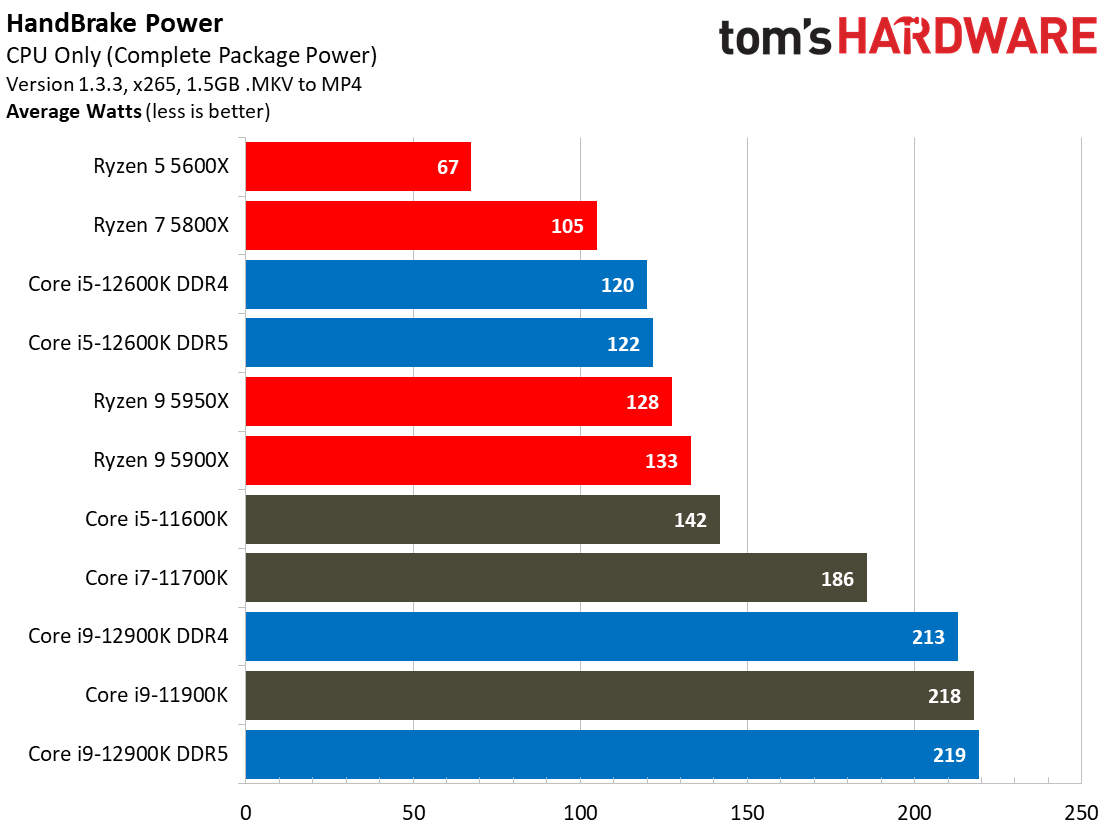
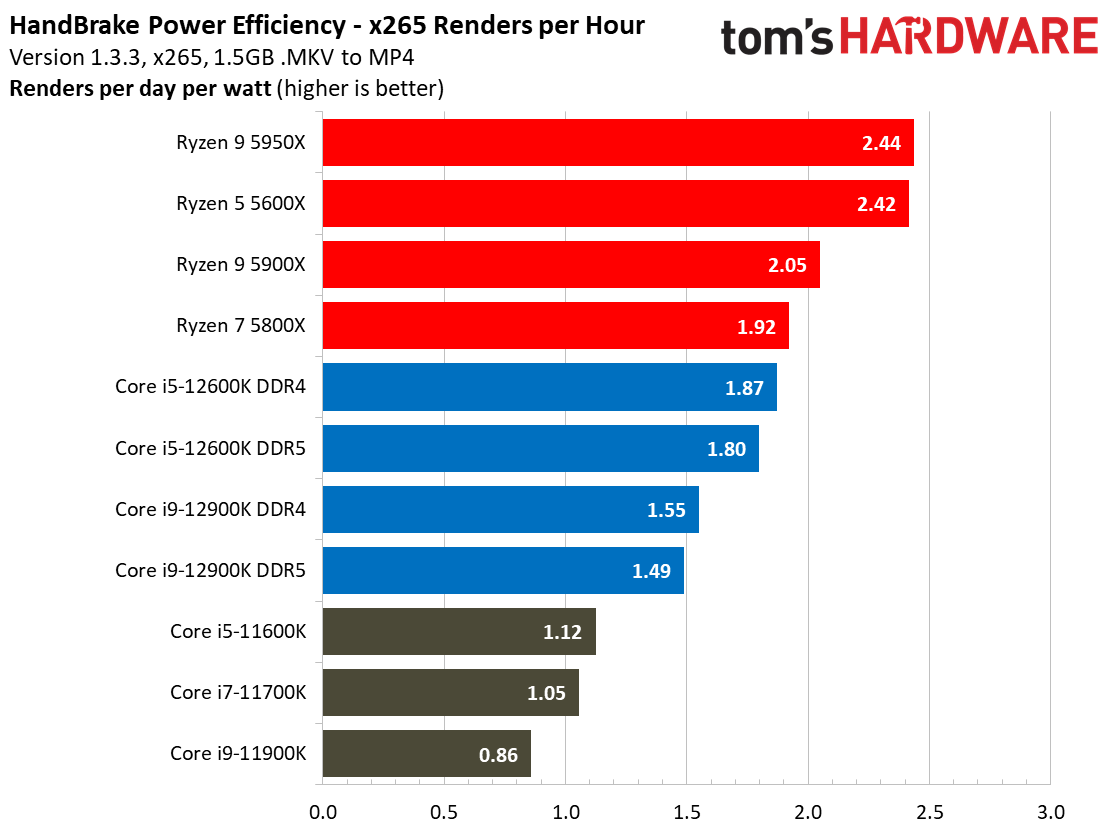
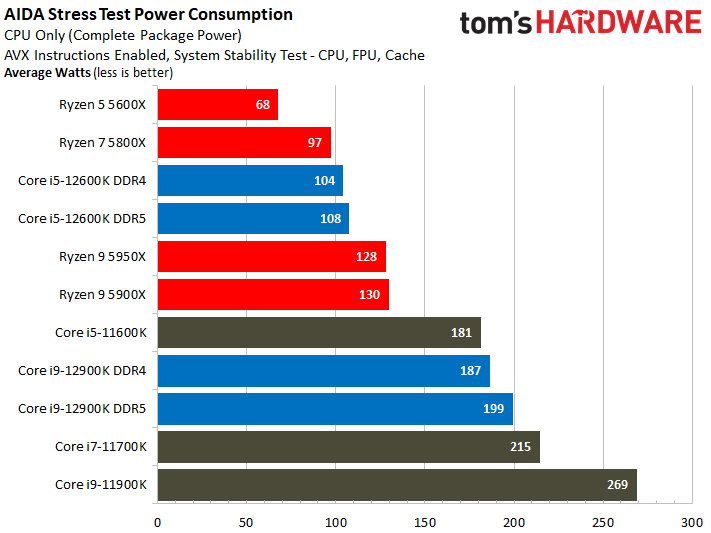
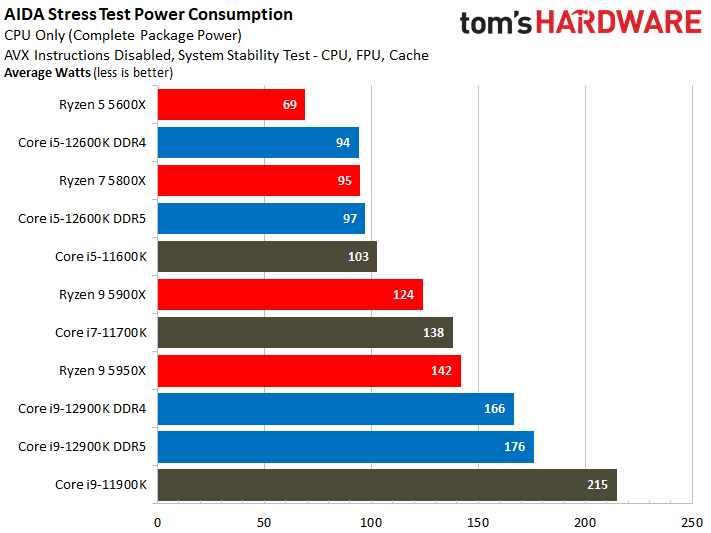




Intel's Core i9-12900K is far more power efficient, meaning it draws less power for each unit of work done, than its predecessor. Yes, Alder Lake still sucks more power than AMD's Ryzen 5000 series chips, but the Intel 7 process marks a big improvement over the old power-guzzling 14nm Rocket Lake chips — we measured a peak of 238W with the 12900K, while the previous-gen 11900K drew nearly 100W more during the same Blender workload.
Alder Lake is also much faster than its predecessor, earning it some leeway. As you can see in our renders-per-day measurements, the Core i9-12900K and 12600K are both twice as efficient as their predecessors, which is impressive.
Overall, Intel has reduced its power consumption from meme-worthy to an acceptable level. The Core i9-12900K ran just fine with our 280mm liquid cooler, so you should budget for an equivalent or better water or air cooler.
The last four slides in the above album tell quite a bit about Intel's improved power efficiency. In these charts, we calculate the cumulative amount of energy required to perform the workloads. We plot this 'task energy' value in Kilojoules on the left side of the chart. These workloads are comprised of a fixed amount of work, so we can plot the task energy against the time required to finish the job (bottom axis), thus generating a really useful power chart.
Bear in mind that faster compute times, and lower task energy requirements, are ideal. That means processors that fall the closest to the bottom left corner of those charts are best. It's easy to see that Intel has made a massive generational improvement here.
However, AMD still holds the advantage in all of the key power criteria, with the Ryzen 5000 models retaining the crown of the most efficient desktop CPUs that we've ever tested.
Winner: AMD
Intel has made plenty of progress, but AMD still holds the crown of the most power-efficient chips. Not only do they suck less peak power, but they also accomplish more work per unit of power consumed. That results in an across-the-board win in power consumption, efficiency, and thermal output, so you'll end up with a cooler and quieter system. None of the chips in our faceoff come with a bundled cooler, but you'll need a beefier cooler to contain the Core i9-12900K than you will for the Ryzen processors.
Pricing: Intel Core i9-12900K vs Ryzen 9 5950X and Ryzen 9 5900X
The Core i9-12900K comes with a boatload of performance for its $598 price tag, and you can even go graphics-less to save some coin with the $564 Core i9-12900KF model. That's exceptionally competitive pricing against AMD's ~$549 Ryzen 9 5900X that trails the 12900K in every meaningful benchmark, and also against the $799 Ryzen 9 5950X that scores shockingly few (narrow) wins against the 12900K. (Notably, you can find the 5900X on sale for around $524 at times, and Microcenter has had sales for $499.)
Platform pricing comes into play, though, and there are a lot of caveats with a Core i9-12900K-powered system. Naturally, DDR5 memory is the elephant in the room, but that equation is pretty simple: You should expect to pay a massive early adopter premium for DDR5 memory, and more for the higher-end DDR5 motherboards. As such, if you're planning on going the DDR5 route, you should plan to pay handsomely — DDR5 memory is mostly out of stock or up to 50% more expensive than DDR4. If you choose to build a DDR5-equipped system, expect the extra costs to outweigh what you would pay for a 5900X-powered system, and possibly a 5950X system, too. If you're looking for bang-for-the-buck, DDR5 is off the table for now (hopefully prices will recede soon).
Luckily, DDR4 offers nearly the same performance in the majority of workloads. So if you aren't after professional-class (i.e., time equals money) performance in workloads that benefit from DDR5, like professional video editing applications and the like, DDR4 will more than suffice for an Alder Lake system. These systems will be built on Z690 motherboards for now, as Intel hasn't released the B- or H-series chipsets yet. However, while plenty of high-end Z690 motherboards support DDR5, most (if not all) of the DDR4-compatible Z690 boards land in the lower- to mid-ranges of the Z690 stack.
It's still a bit early to get the complete picture on motherboard pricing, Alder Lake launched just this week, and we're seeing the normal spotty availability, but here are a few like-for-like comparisons (pricing is valid only at the time of publication):
| Row 0 - Cell 0 | Price |
| MSI PRO Z690-A DDR4 | $154 |
| MSI X570-A PRO | $209 |
| ASRock Z690 Phantom Gaming 4 | $180 |
| ASRock X570 PHANTOM GAMING 4 | $154 |
| ASUS Prime Z690-P D4 | $220 |
| ASUS PRIME X570-P | $172 |
As you can see, we're looking at price deltas that range from $26 to $55 between the X570 and Z690 DDR4 motherboards, with the latter being more expensive. Of course, you'll have to add in those costs if you plan to build around the 12900K. However, given that AMD's AM4 ecosystem is more robust due to B- and H-series availability, you can even step down a bit further for a 5900X or 5950X-based system.
However, there are a lot of intangibles at play. Generally, we would expect a Core i9-12900K chip and DDR4 motherboard to cost roughly $100 more than a Ryzen 9 5900X on a similar board, and ~$75 to $100 less than a Ryzen 9 5950X combo with similar trimmings.
Winner: Tie
Intel Core i9-12900K systems outfitted with DDR5 memory will come at a big premium that might not be worth the slim performance gains over DDR4 in most applications. Given the early state of DDR5 availability, it's hard to nail down firm estimates. However, the high pricing of DDR5 isn't worth it for most users, which removes one of the key reasons to go with an Alder Lake system.
Given the additional connectivity you gain with the Z690 platform, not to mention the performance advantages of the chip, Intel's Core i9-12900K comes out ahead if you're building around a DDR4-based system. Core i9-12900K platforms built around DDR4 memory should be more expensive than a similar system than a Ryzen 9 5900X, and slightly less expensive than the Ryzen 9 5950X. Factoring in the Core i9-12900K's exceptional performance and more modern chipset with advanced connectivity options, it wins the pricing war for DDR4-based systems. That yields a tie in this section.
Bottom Line
| Row 0 - Cell 0 | Intel Core i9-12900K | AMD Ryzen 9 5900X and 5950X |
| Features and Specifications | X | Row 1 - Cell 2 |
| Gaming | X | Row 2 - Cell 2 |
| Application Performance | X | Row 3 - Cell 2 |
| Overclocking | X | X |
| Power Consumption, Efficiency, and Cooling | Row 5 - Cell 1 | X |
| Pricing | X | X |
| Total | 5 | 3 |
The Core i9-12900K vs Ryzen 9 5900X and 5950X battle ends in a five to three win in Intel's favor. It might seem odd that we put the Core i9-12900K up against both the Ryzen 9 5900X and 5950X, especially with the latter being around $200 more expensive, but that's because the 12900K has the performance chops to challenge both chips. As such, we expect AMD to reduce pricing soon, perhaps bringing 5950X pricing closer to the 12900K.
Software updates should help resolve many of the early issues in Windows 10, but you might need to engage in some manual tweaking for some specific programs. However, despite those early hiccups with Windows 10, Intel's gamble to adopt a hybrid x86 architecture has clearly paid off.
The Core i9-12900K lands at $589 for the full-featured model and $564 for the graphics-less variant. The 12900K delivers incredible performance in threaded workloads, often rivaling or beating the $799 Ryzen 9 5950X, but at a much lower price point. Yes, the Ryzen 9 5950X does beat the 12900K in some threaded work, but by surprisingly slim deltas given its higher pricing. Additionally, the 12900K beats the ~$499 to $549 Ryzen 9 5900X in all performance metrics. If you're looking for snappy performance in lighter fare, the 12900K is also the uncontested leader in x86 single-threaded performance, bar none.
The Core i9-12900K is the fastest gaming chip on the planet, regardless of if you use Windows 10 or 11 or DDR4 or DDR5. AMD will fire back with its 3D V-Cache processors that will come with up to 192MB of L3 cache per chip, which the company says imparts up to 15% more gaming performance. Those chips arrive next year, but the impact on gaming beyond eSports titles is unknown.
Alder Lake's advantages also include platform connectivity, but DDR5 and PCIe 5.0 interfaces will add some cost in the early days. Support for DDR4 can help reduce that overhead, but we haven't seen any flagship DDR4 motherboards yet; the highest-end models appear to be confined to DDR5. Luckily, you won't need expensive DDR5 memory to unlock the best gaming performance — unless you have a very specific need for DDR5, it's probably best to skip it until it matures further.
Intel's very aggressive pricing gives it the overall lead against AMD's competing Ryzen 5000 chips, at least if you're building a DDR4 system. The competitive pricing could also take some of the sting out of the high platform costs associated with the Z690 motherboards that are currently the only option for Alder Lake systems. If you're going with a DDR5 build, prepare yourself for eye-watering pricing, at least until supply improves. Eventually, we'll see B- and H-series motherboards come to market, which should help reduce platform costs.
AMD still holds the power and efficiency crown, but the 12900K's new 'Intel 7' process reduces power consumption by up to a third and nearly doubles power efficiency, reducing AMD's massive advantage in that key area. Overall, if we take performance into account, Intel has reduced its power consumption from meme-worthy to an acceptable level.
Overall, the Core i9-12900K marks a massive generational leap forward for Intel in nearly all facets, including gaming, performance in lightly- and heavily-threaded work, power consumption and efficiency, and platform connectivity options. Paired with aggressive pricing, the Core i9-12900K wins the faceoff with the Ryzen 9 5900X and 5950X in convincing fashion.
- MORE: Best CPUs for Gaming
- MORE: CPU Benchmark Hierarchy
- MORE: AMD vs Intel
- MORE: All CPUs Content
| Intel Socket 1700 DDR5 (Z690) | Core i9-12900K, Core i5-12600K |
| Row 1 - Cell 0 | MSI Z690 Carbon WiFi |
| Row 2 - Cell 0 | 2 x16GB G.Skill Ripjaws S5, DDR5-5200 @ DDR5-4400 36-36-36-72 |
| Intel Socket 1700 DDR4 (Z690) | Core i9-12900K, Core i5-12600K |
| Row 4 - Cell 0 | MSI Z690A WiFi DDR4 |
| Row 5 - Cell 0 | 2x 8GB Trident Z Royal DDR4-3600 - Stock: DDR4-3200 14-14-14-36 |
| Intel Socket 1200 (Z590) | Core i9-11900K, Core i7-11700K, Core i5-10600K |
| Row 7 - Cell 0 | MSI Z590 Godlike |
| Row 8 - Cell 0 | 2x 8GB Trident Z Royal DDR4-3600 - Stock DDR4-3200/2933 Gear 1 |
| AMD Socket AM4 (X570) | AMD Ryzen 9 5950X, Ryzen 9 5900X, Ryzen 7 5800X, Ryzen 5 5600X |
| MSI MEG X570 Godlike | |
| Row 11 - Cell 0 | 2x 8GB Trident Z Royal DDR4-3600 - Stock: DDR4-3200 14-14-14-36 |
| All Systems | Gigabyte GeForce RTX 3090 Eagle - Gaming and ProViz applications |
| Row 13 - Cell 0 | Nvidia GeForce RTX 2080 Ti FE - Application tests |
| 2TB Intel DC4510 SSD | |
| Silverstone ST1100-TI | |
| Row 16 - Cell 0 | Open Benchtable |
| Windows 10 Pro version 2004 (build 19041.450) | |
| Row 18 - Cell 0 | Windows 11 Pro version |
| Cooling | Corsair H115i, Custom loop |

Paul Alcorn is the Editor-in-Chief for Tom's Hardware US. He also writes news and reviews on CPUs, storage, and enterprise hardware.
-
spongiemaster ReplyAs such, we expect AMD to reduce pricing soon, perhaps bringing 5950X pricing closer to the 12900K.
That's wishful thinking. Where can you buy a 5950x in the US for MSRP? There's no reason to lower the price on a CPU that has almost never been available since its launch a year ago. It's unlikely you'll be able to find a 12900k any time soon either. The prices AMD needs to lower are the 5600x and 5800x. Both are often in stock, and the 5600x has been a terrible value since day one, now that the 12600k is just beating it into submission at only $10 more, the 5600x needs to be dropped to the $200-$250 range it should have been all along. Same thing with the 5800x. It's in stock and basically trading blows with the $319 12600k (in stock at that price now at Newegg and Amazon). 5800x is selling for 386 at Newegg right now. Needs to come down another $50 or so. -
Alvar "Miles" Udell Replyspongiemaster said:That's wishful thinking. Where can you buy a 5950x in the US for MSRP? There's no reason to lower the price on a CPU that has almost never been available since its launch a year ago. It's unlikely you'll be able to find a 12900k any time soon either. The prices AMD needs to lower are the 5600x and 5800x. Both are often in stock, and the 5600x has been a terrible value since day one, now that the 12600k is just beating it into submission at only $10 more, the 5600x needs to be dropped to the $200-$250 range it should have been all along. Same thing with the 5800x. It's in stock and basically trading blows with the $319 12600k (in stock at that price now at Newegg and Amazon). 5800x is selling for 386 at Newegg right now. Needs to come down another $50 or so.
B&H has it for $750 on sale right now.
AMD Ryzen 9 5950X 3.4 GHz 16-Core AM4 Processor 100-100000059WOF (bhphotovideo.com) -
Makaveli Replyspongiemaster said:That's wishful thinking. Where can you buy a 5950x in the US for MSRP? There's no reason to lower the price on a CPU that has almost never been available since its launch a year ago. It's unlikely you'll be able to find a 12900k any time soon either. The prices AMD needs to lower are the 5600x and 5800x. Both are often in stock, and the 5600x has been a terrible value since day one, now that the 12600k is just beating it into submission at only $10 more, the 5600x needs to be dropped to the $200-$250 range it should have been all along. Same thing with the 5800x. It's in stock and basically trading blows with the $319 12600k (in stock at that price now at Newegg and Amazon). 5800x is selling for 386 at Newegg right now. Needs to come down another $50 or so.
Can't speak for the US however in Canada there is plenty of stock of all 3 ADL-S cpu's aswell as all the Zen 3 cpu's.
-
spongiemaster Reply
Looks like Newegg has it in stock currently for $740. Maybe demand tanked in anticipation for Alder Lake, as there's no denying this hasn't been an easy CPU to track down in the US since launch.Alvar Miles Udell said:B&H has it for $750 on sale right now.
AMD Ryzen 9 5950X 3.4 GHz 16-Core AM4 Processor 100-100000059WOF (bhphotovideo.com) -
spongiemaster Reply
The 12600 and 12700's are readily available (You taking notes AMD?), only the 12900k seems to be in shortage. For some reason, it doesn't even appear on Newegg right now.Makaveli said:Can't speak for the US however in Canada there is plenty of stock of all 3 ADL-S cpu's aswell as all the Zen 3 cpu's.
-
Makaveli Replyspongiemaster said:The 12600 and 12700's are readily available (You taking notes AMD?), only the 12900k seems to be in shortage. For some reason, it doesn't even appear on Newegg right now.
You have to remember AMD is much smaller than Intel and they don't own their own fab. It should be expected Intel will have more available at launch. -
SkyBill40 ReplyMakaveli said:You have to remember AMD is much smaller than Intel and they don't own their own fab. It should be expected Intel will have more available at launch.
This is only because TSMC perhaps slowed down fabrication of other vendor wafers so that Intel could get their stuff out. Intel did NOT produce these chips as they couldn't make it work. That much is evident with their desktop 10nm parts getting kicked to the curb because their QC was poor. -
ingtar33 Reply
this is false; alder lake was make at intel fabs.SkyBill40 said:This is only because TSMC perhaps slowed down fabrication of other vendor wafers so that Intel could get their stuff out. Intel did NOT produce these chips as they couldn't make it work. That much is evident with their desktop 10nm parts getting kicked to the curb because their QC was poor.
that said this whole article is hilarious since there currently are hundreds of modern games which cannot run on alderlake due to the denuvo anti piracy junk included with them thinking the big/little core design is some sort of piracy mechanic
Until that is addressed, alderlake is dead in gaming circles. still beautiful chip from intel; only took them 7 years to actually improve upon skylake. -
robert3892 The test setup for AMD is 3200 Mhz memory versus DDR5 4400 MHZ. It's a skewed test setup in my personal opinion. A more correct test setup would have been a higher DDR4 frequency memory as close to DDR5 4400 Mhz as possible.Reply -
Co BIY No need for AMD to lower prices. I bet a lot of AMD builds were started after the Alder Lake reviews showed a narrow intel lead but no blowout.Reply
AMD still has the motherboard advantage (lots of motherboards to upgrade, lots of boards on the market and available, and some price advantage).
AMD also benefits from the DDR4/DDR5 confusion with Intel 12.
If they needed or wanted to it's not clear that AMD can lower prices very much. They have to pay for production and TSMC is raising prices and reducing discounts.
Also, In this inflationary environment holding prices steady is an effective price reduction.